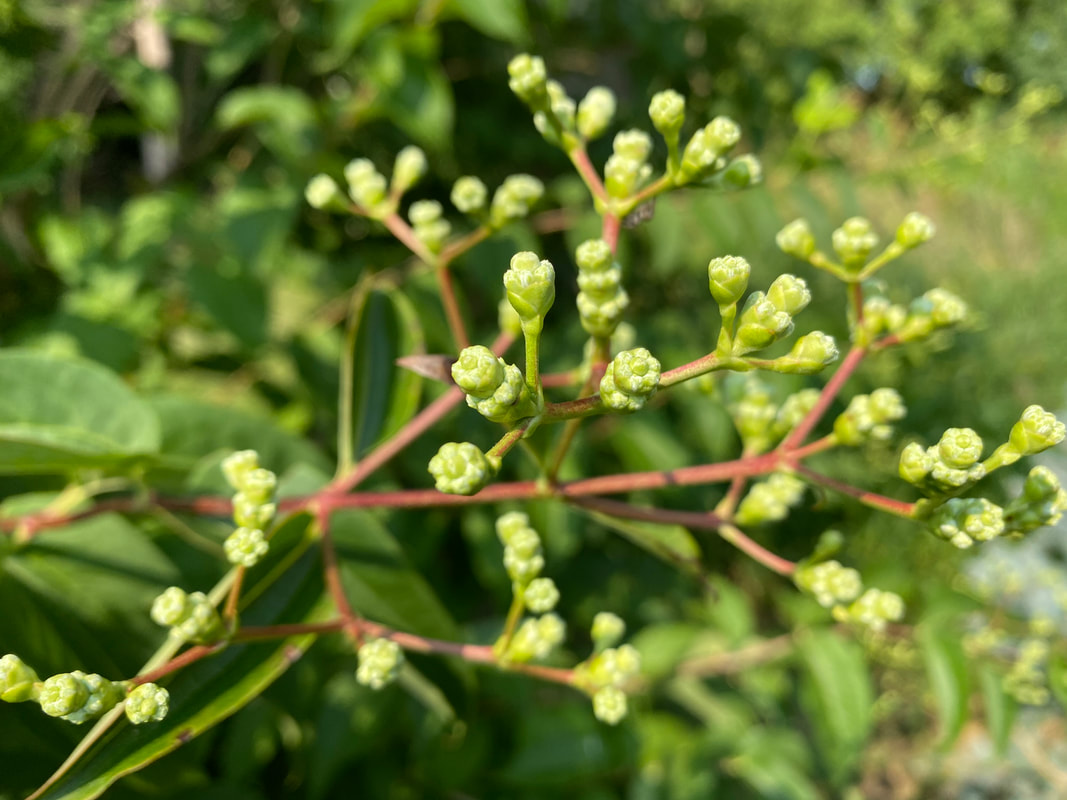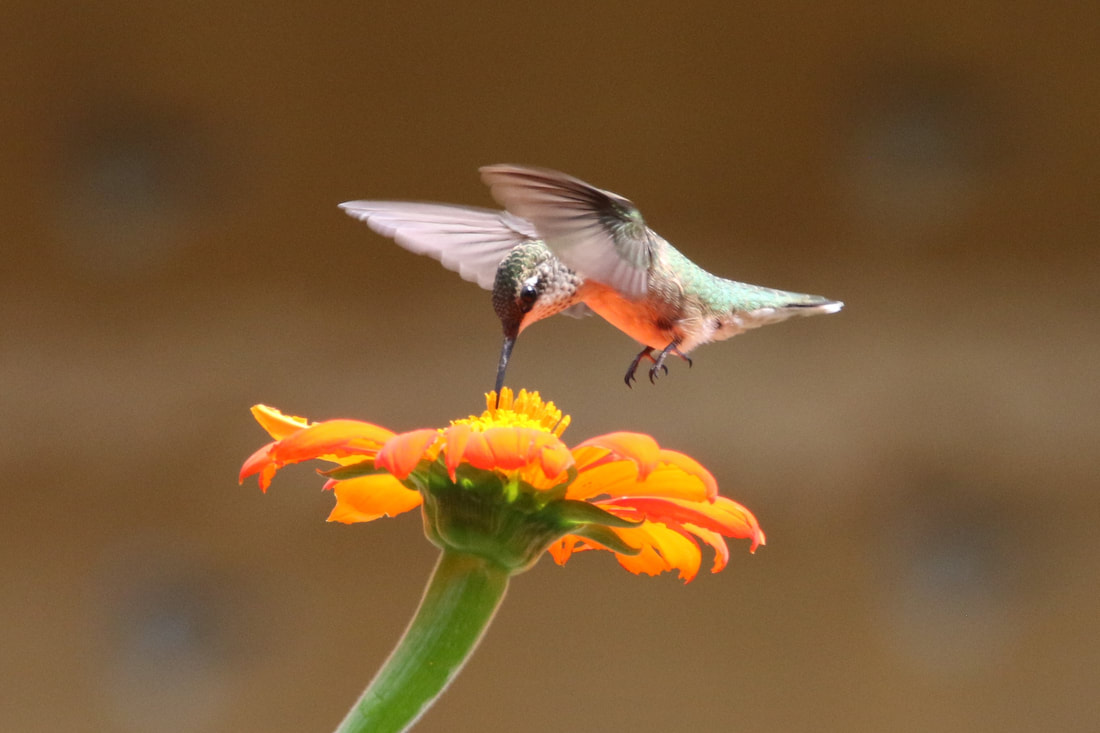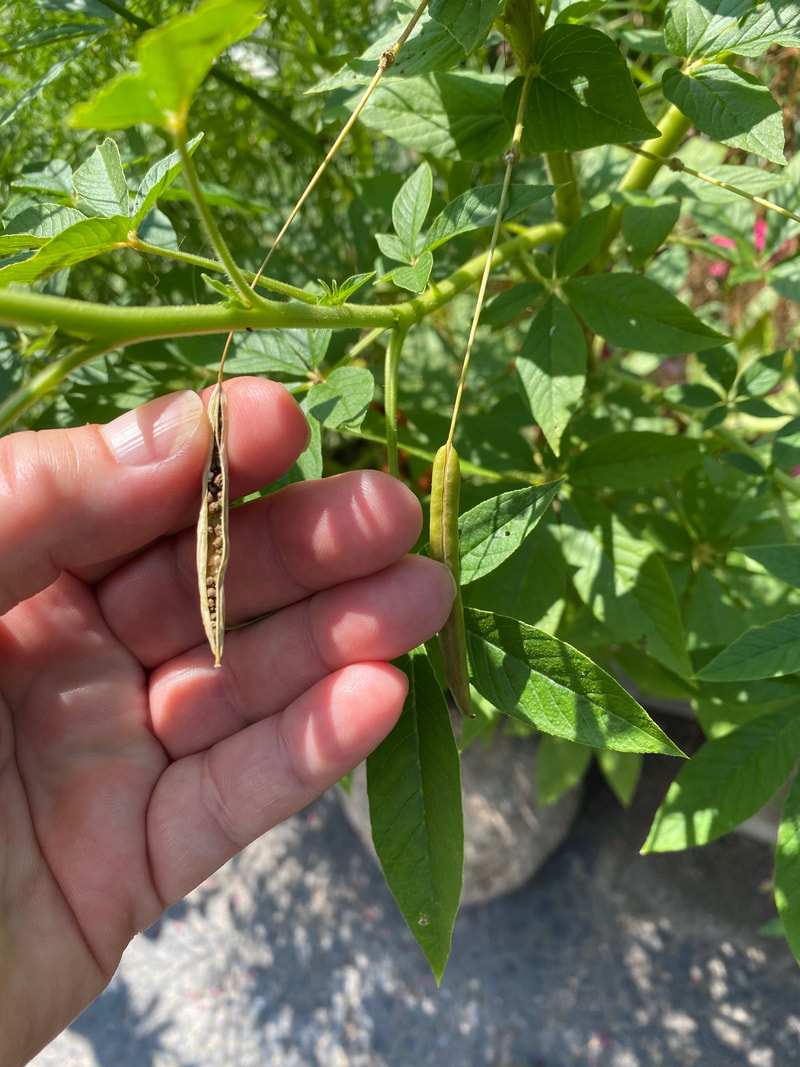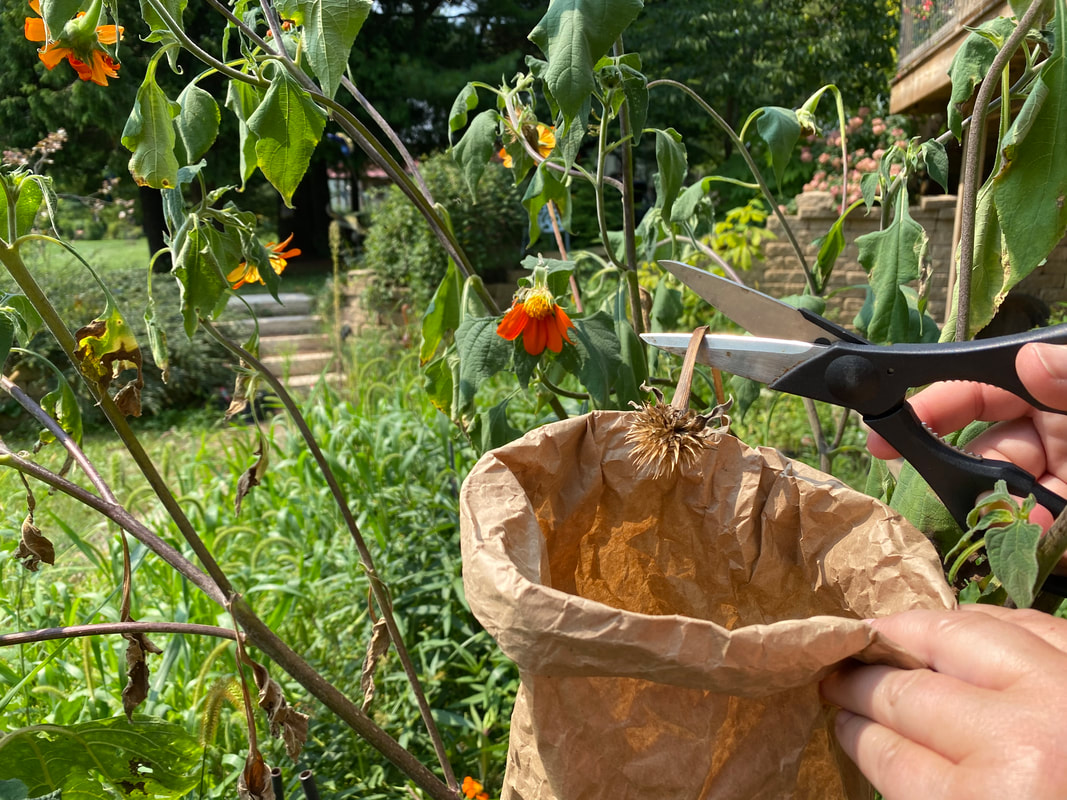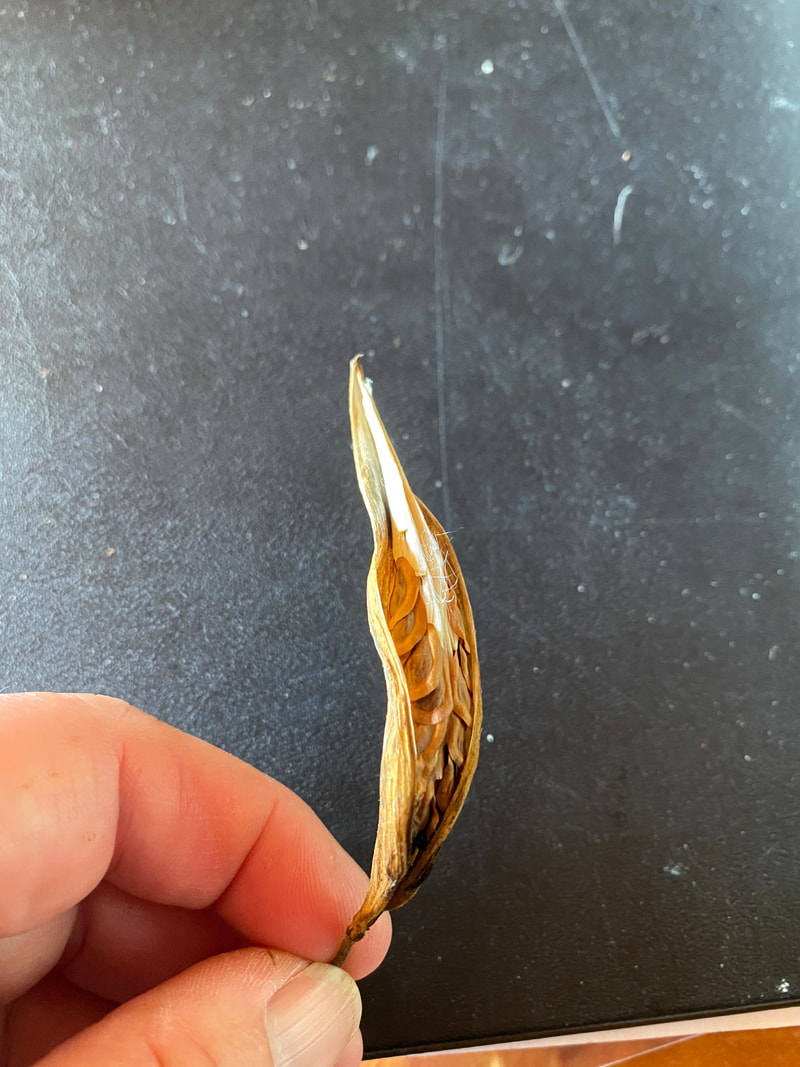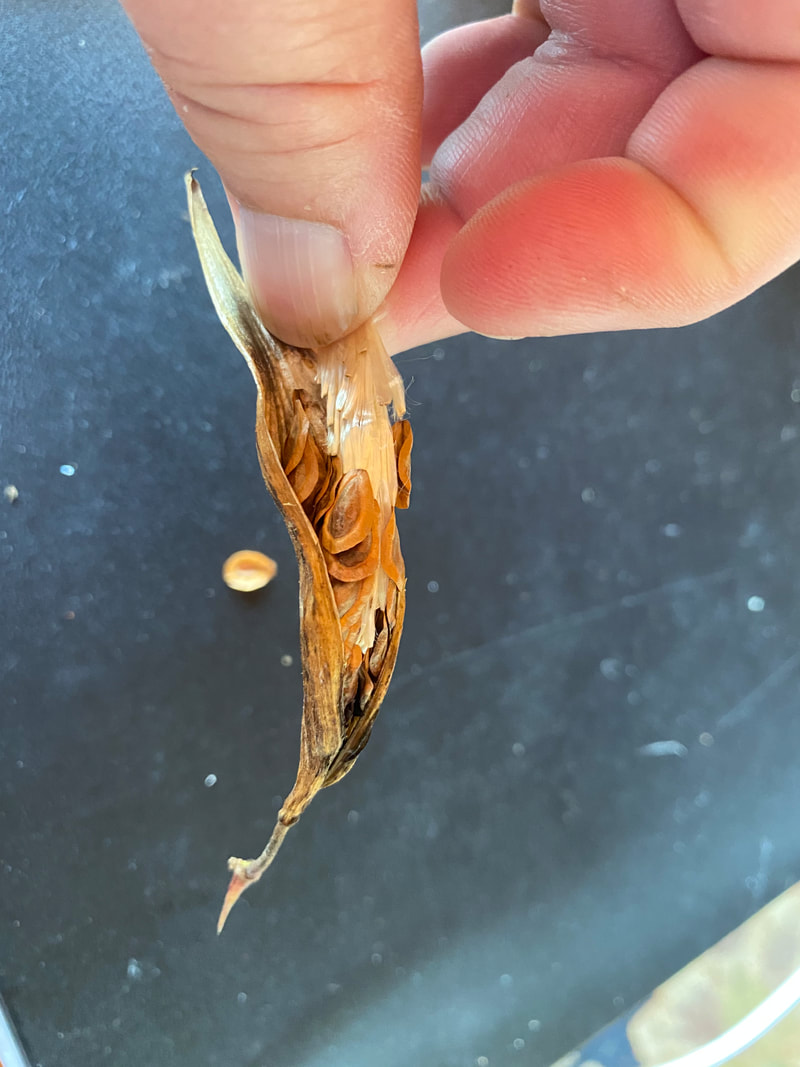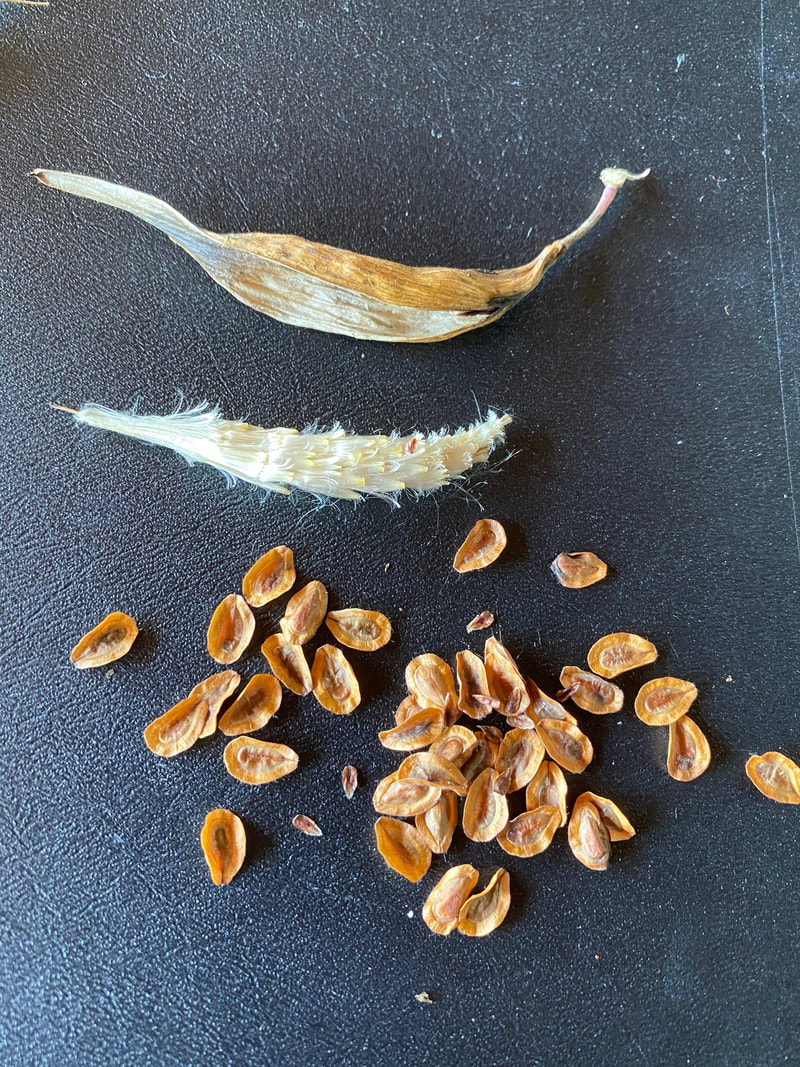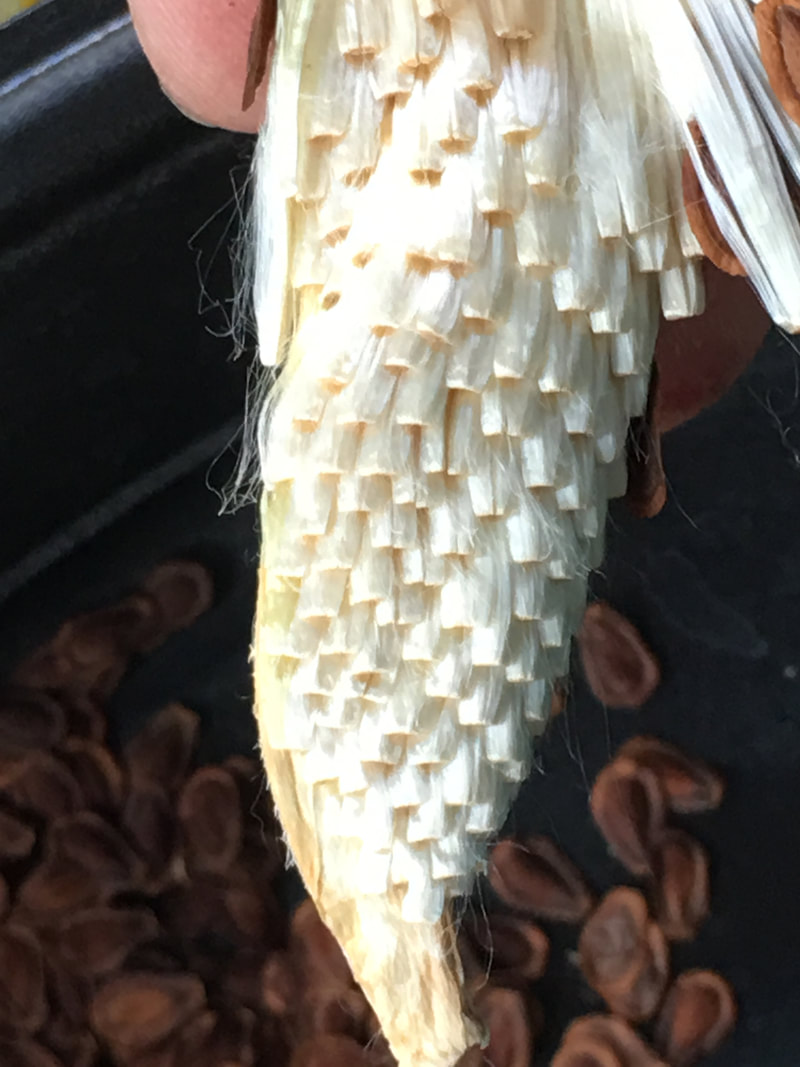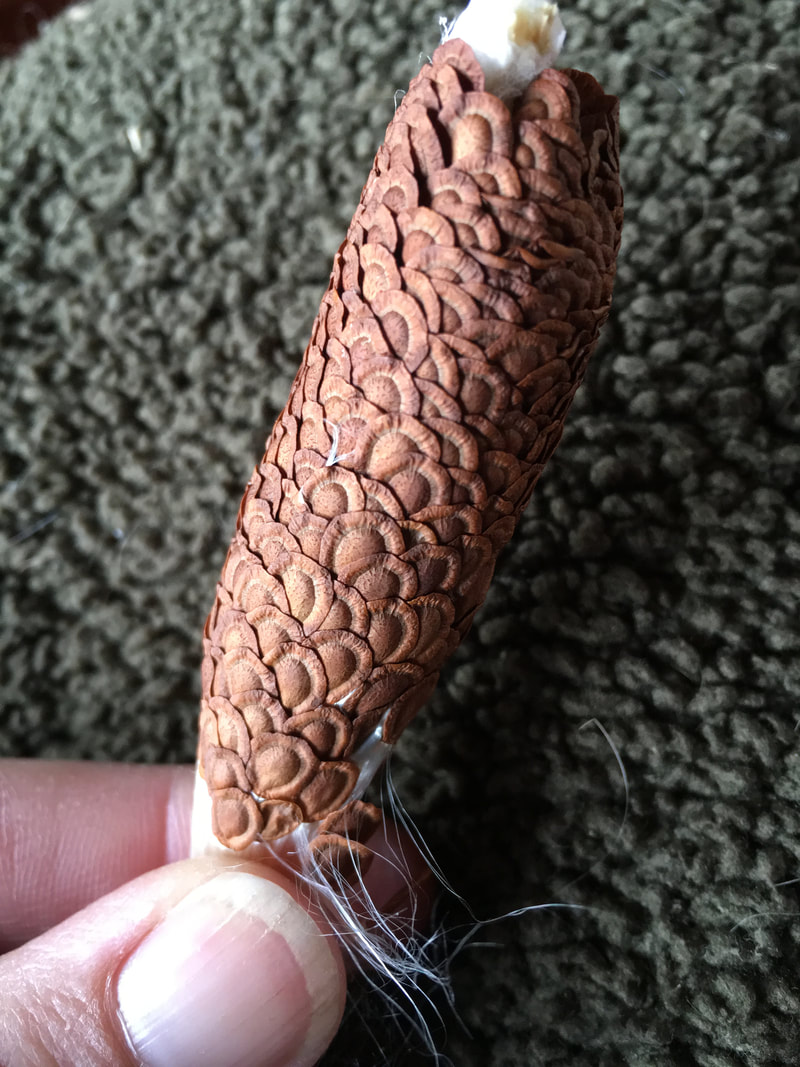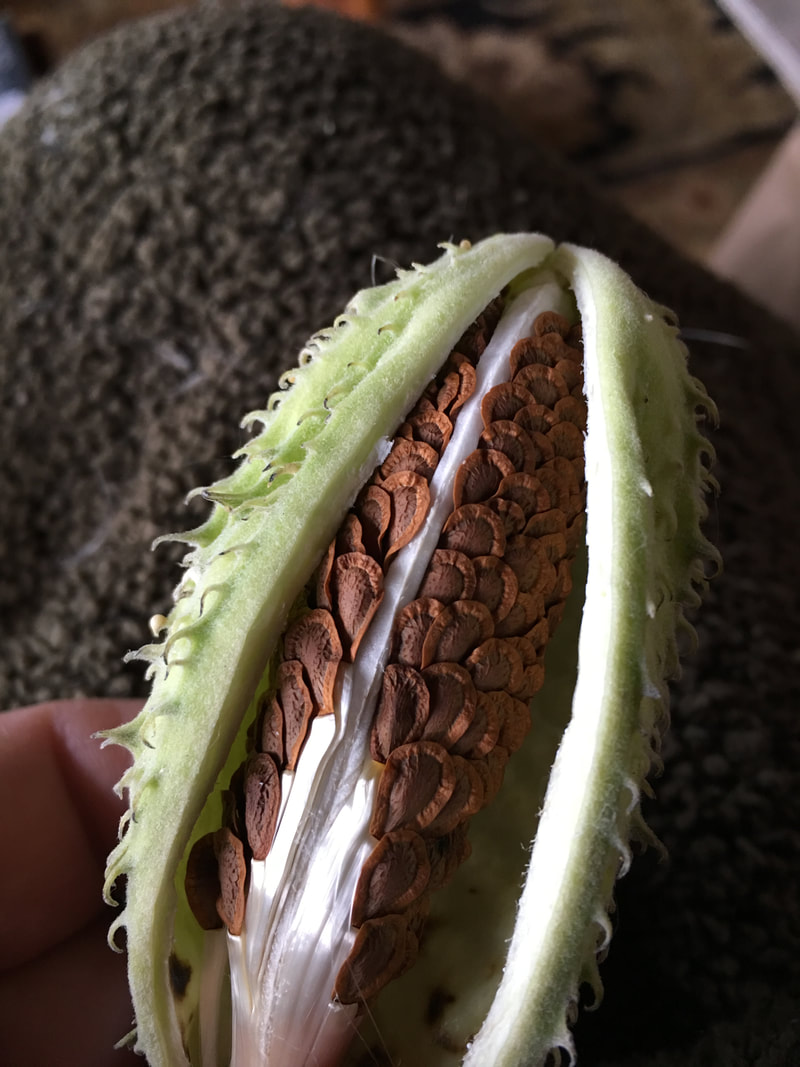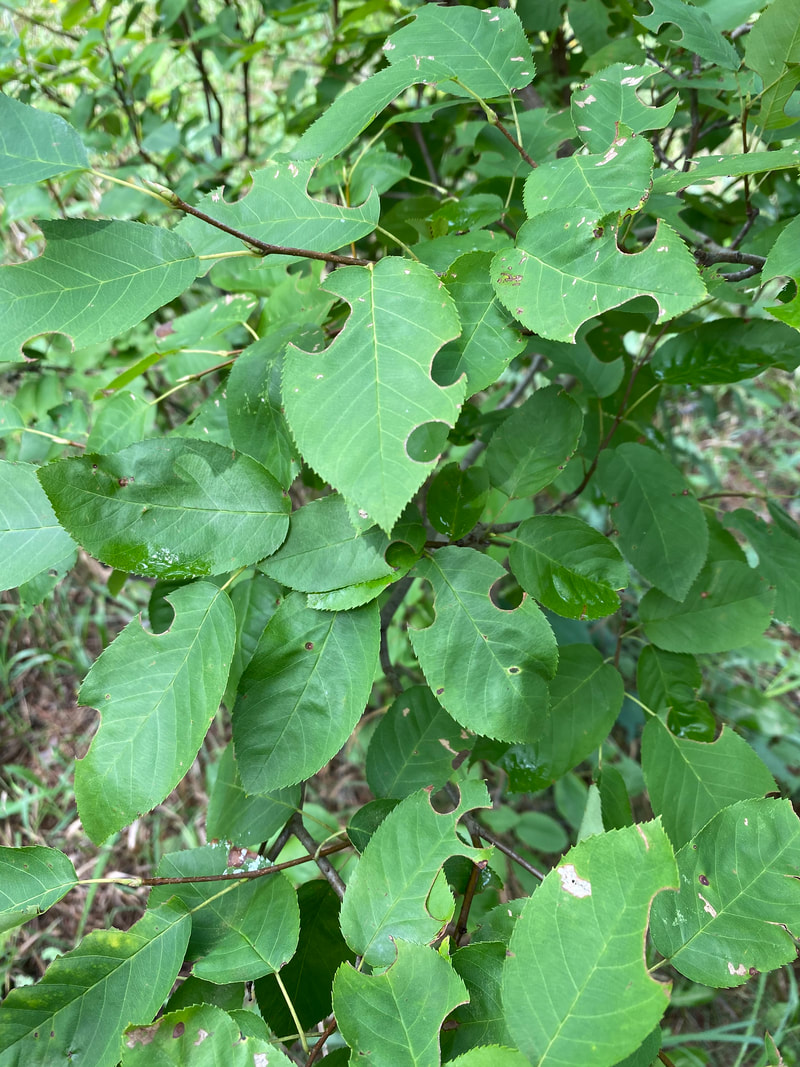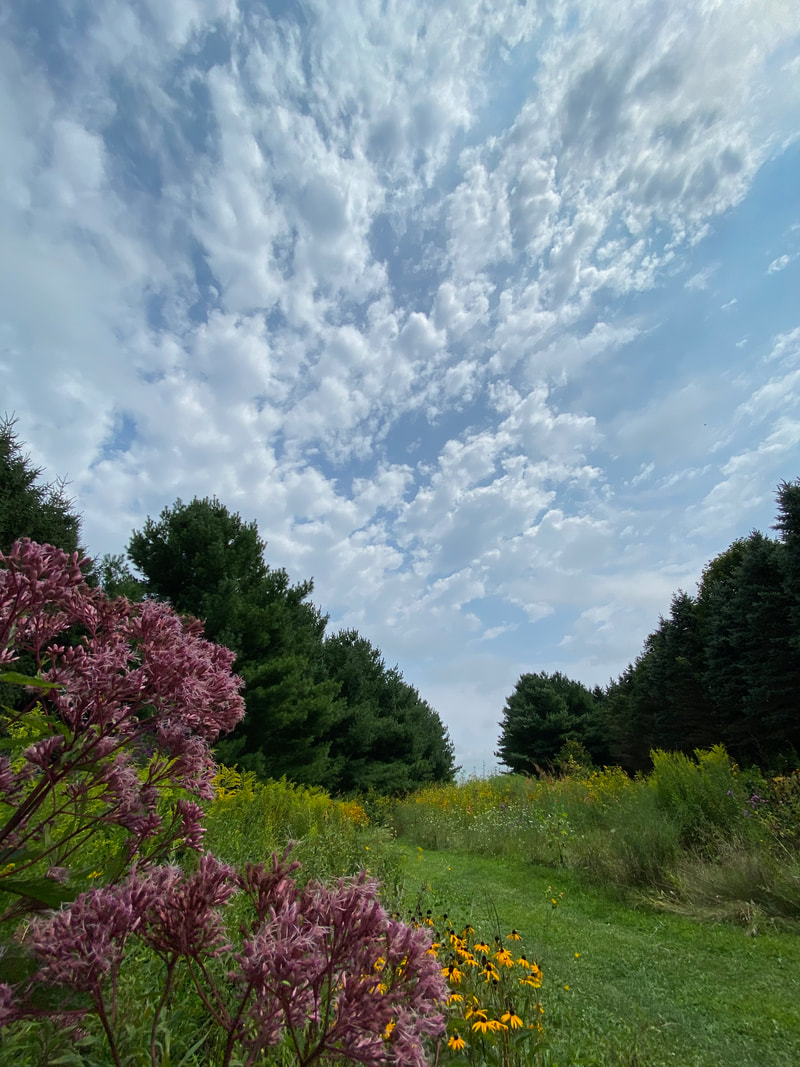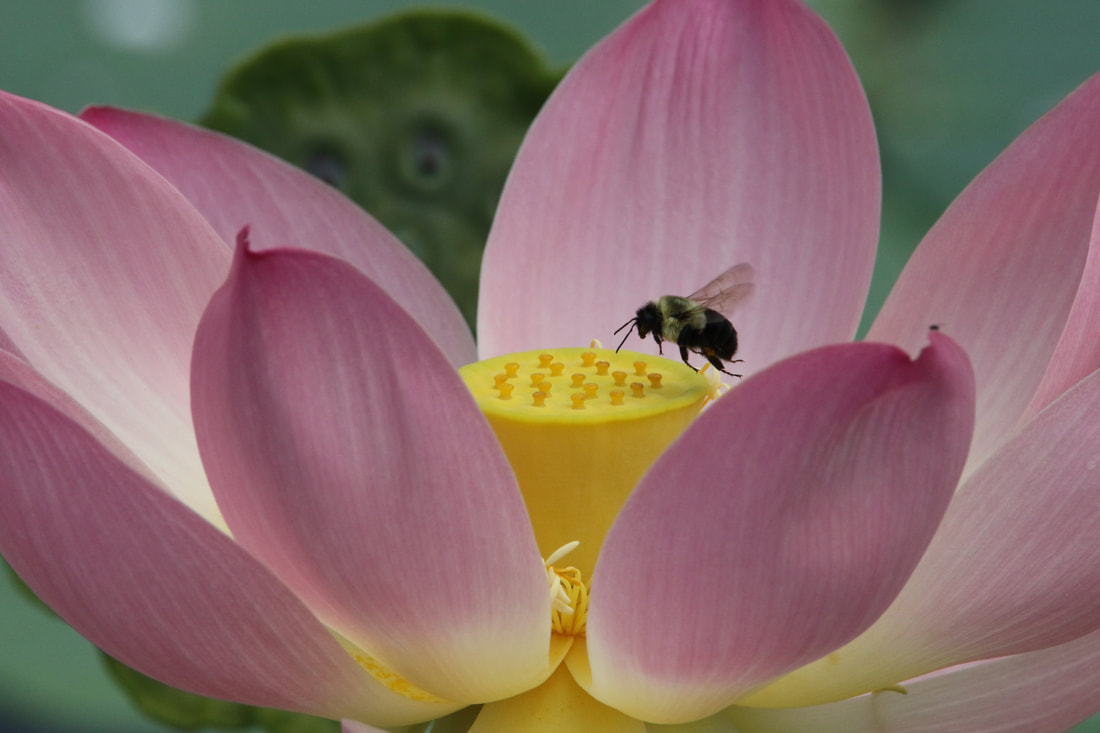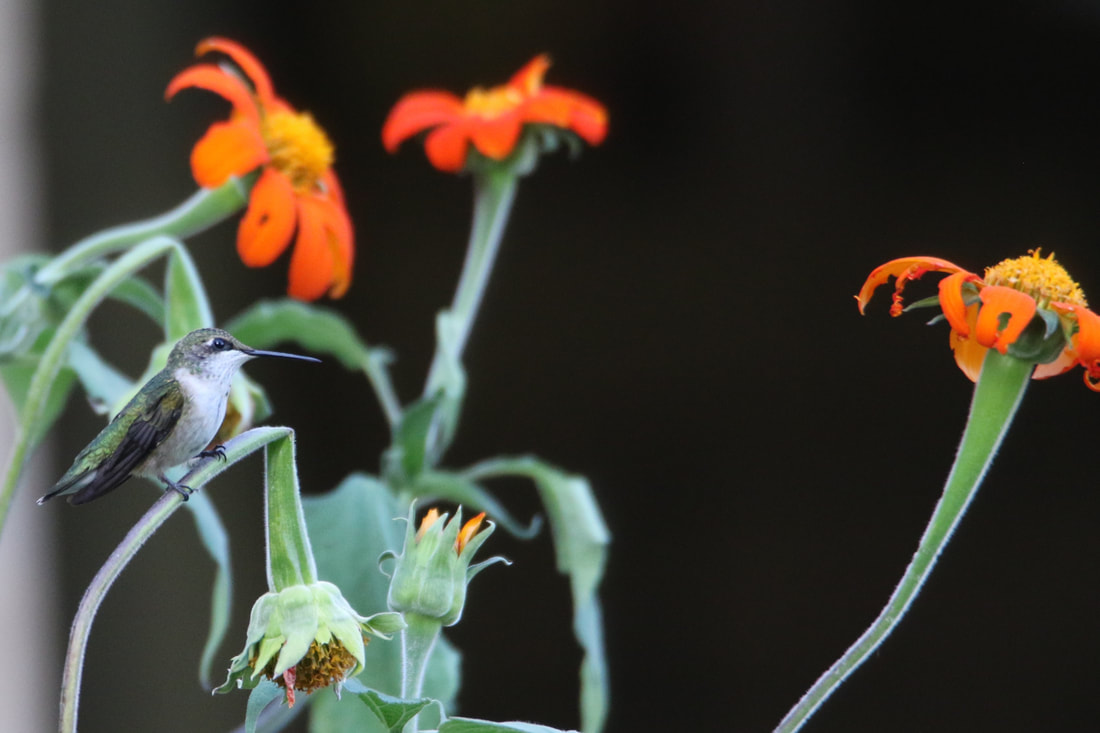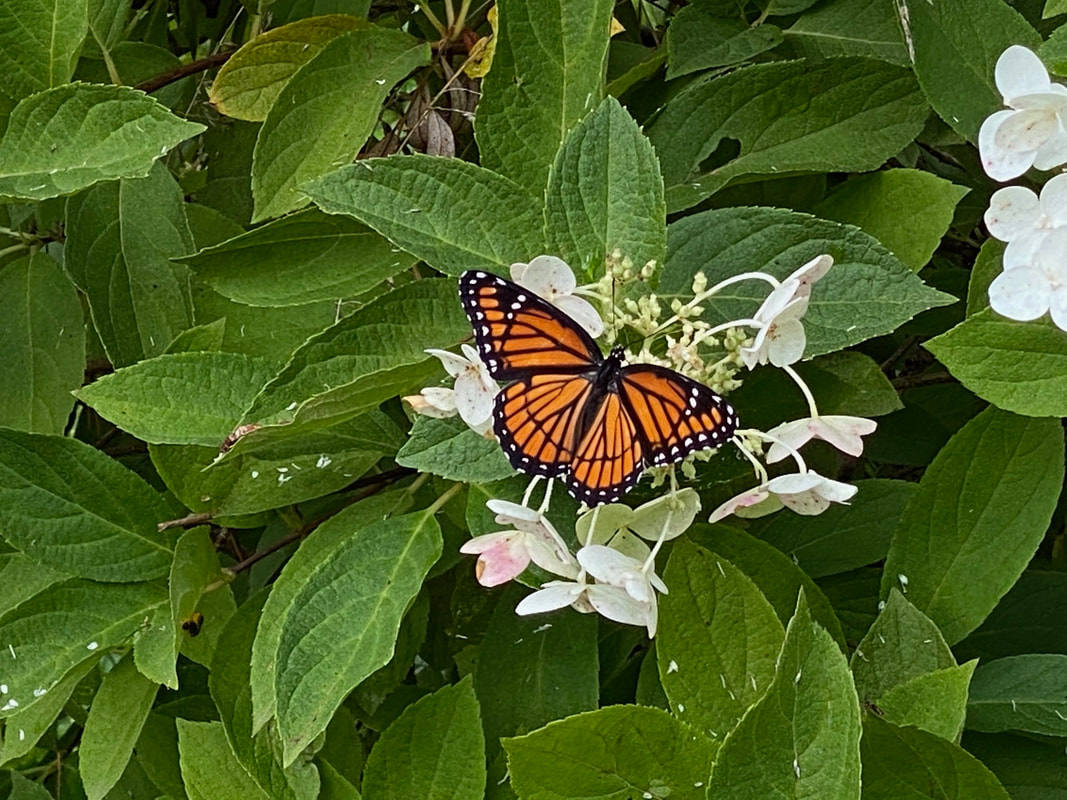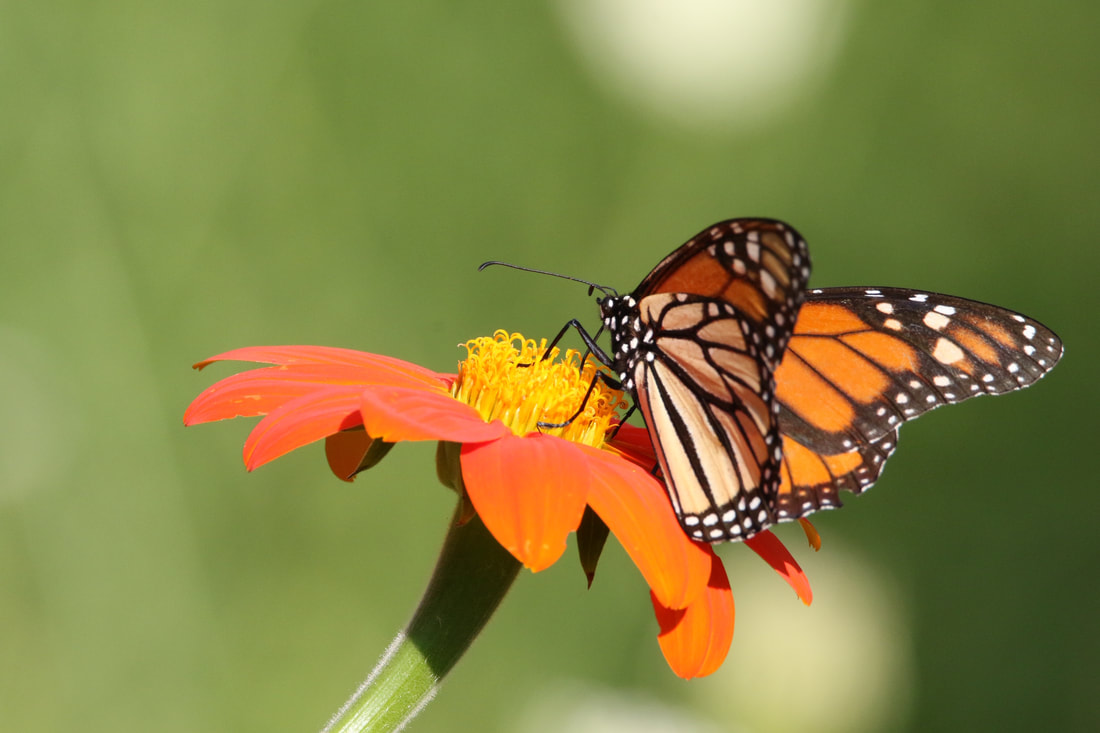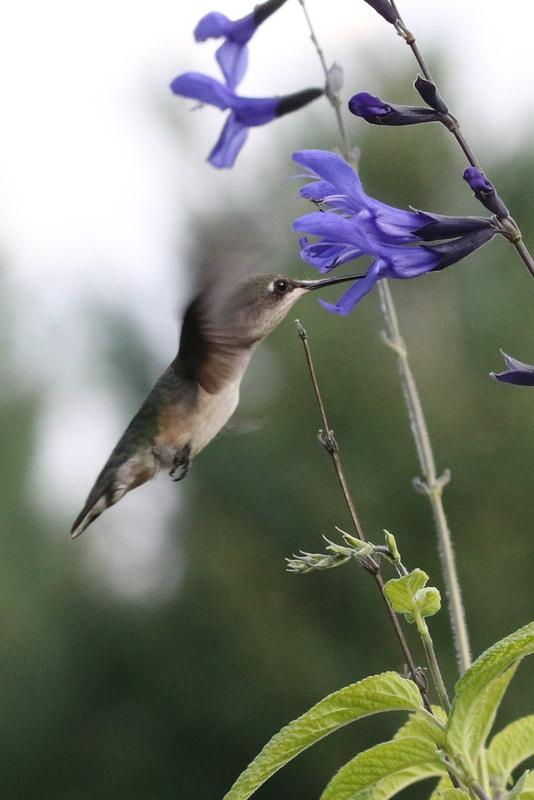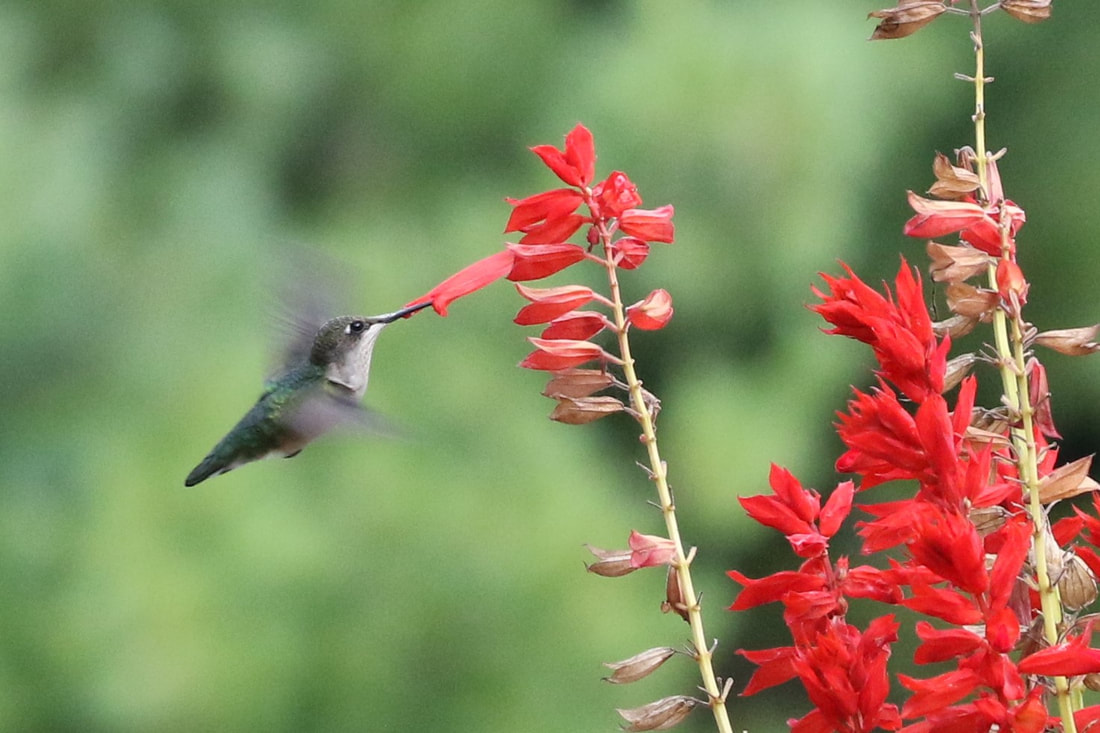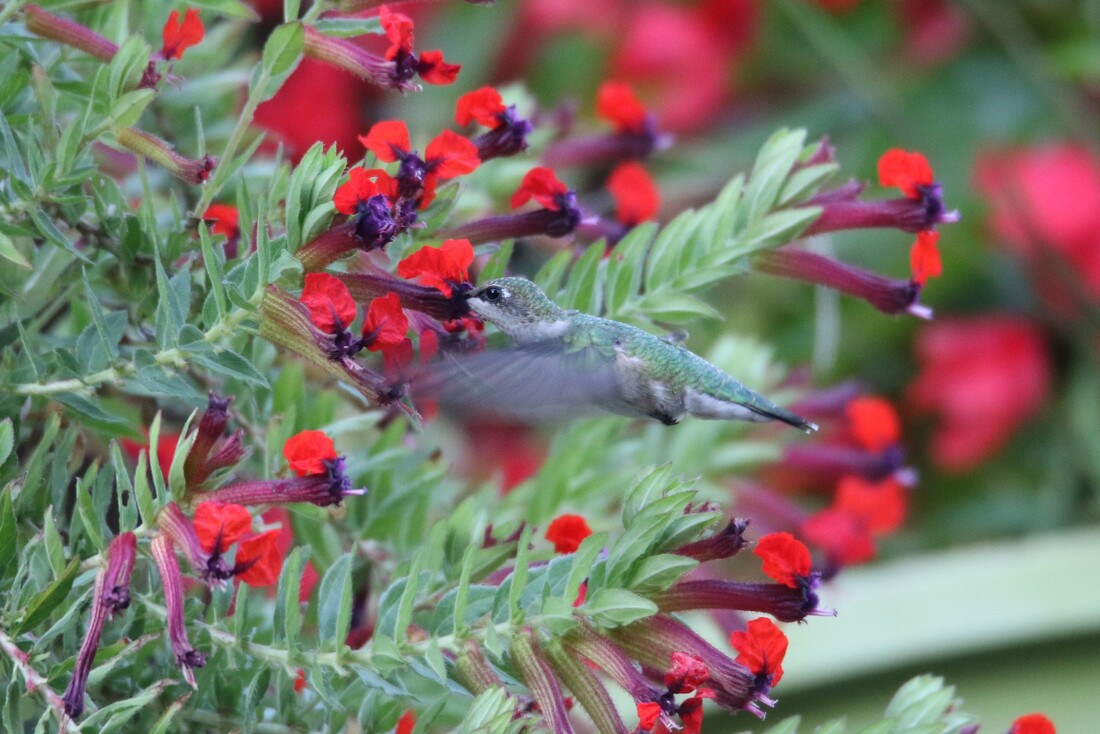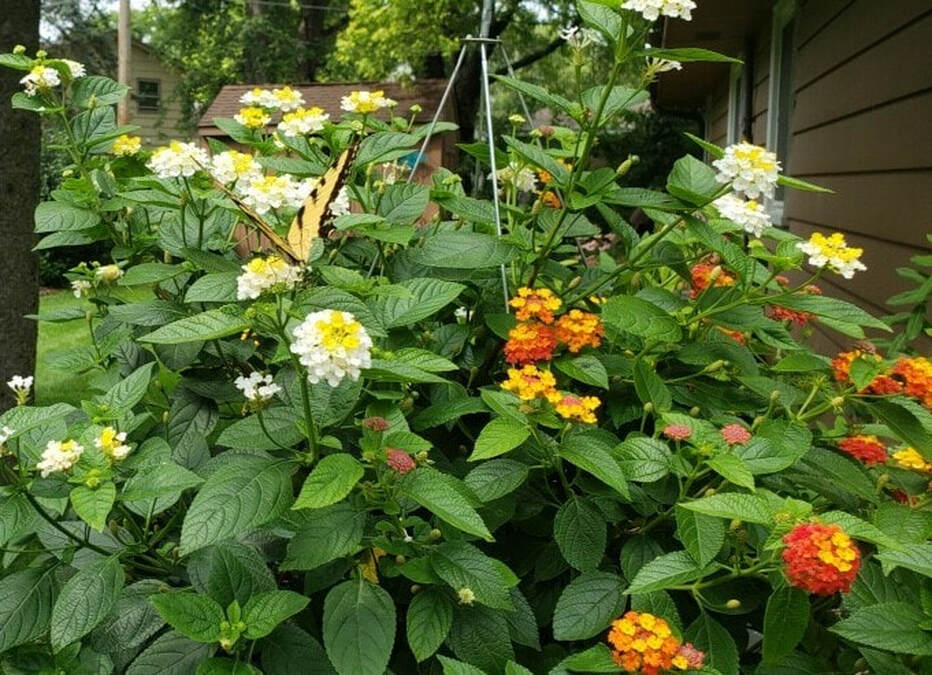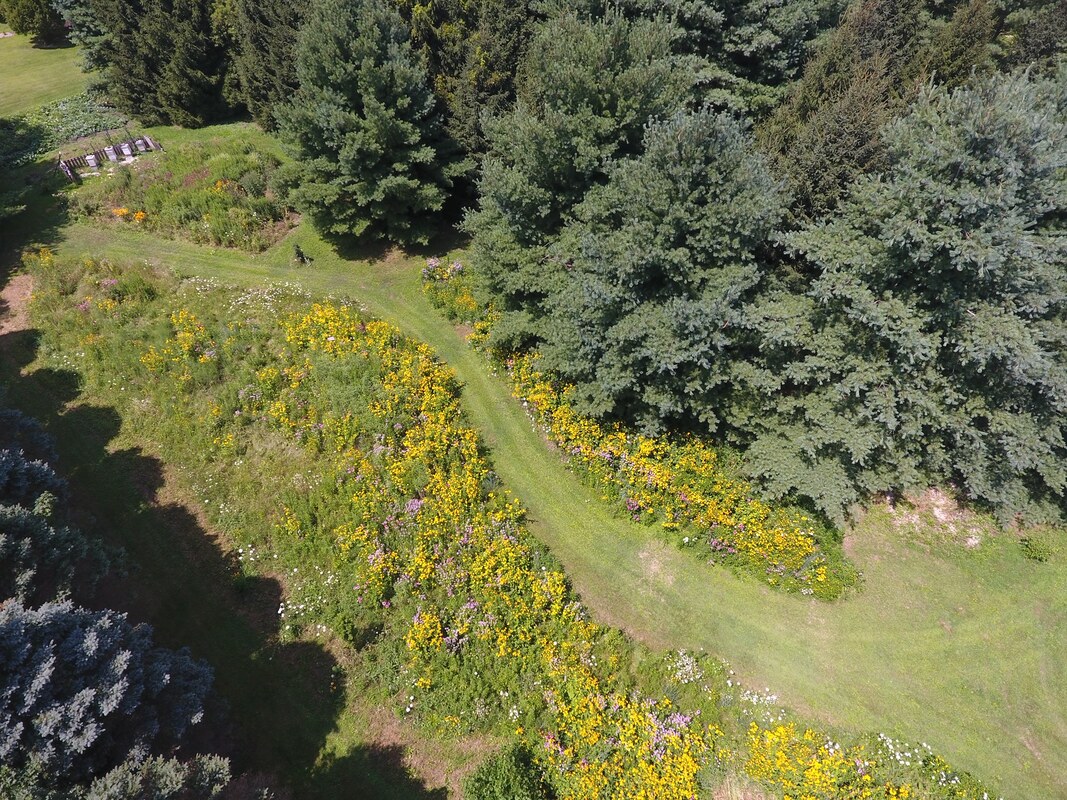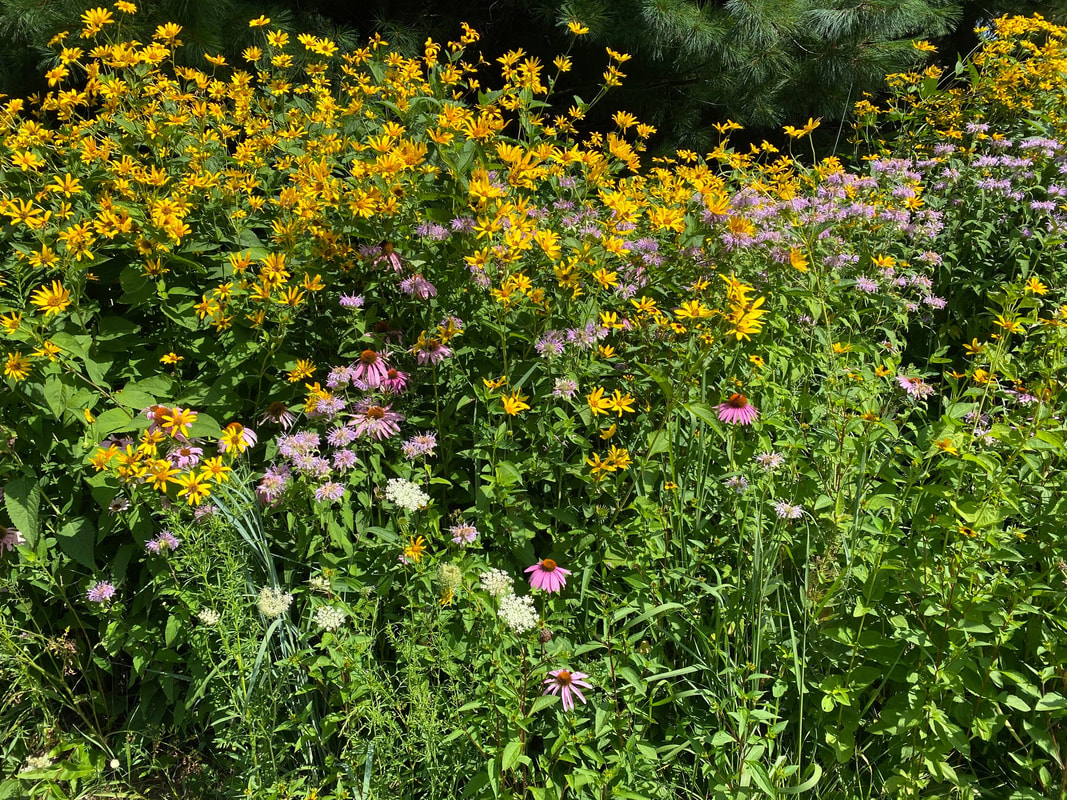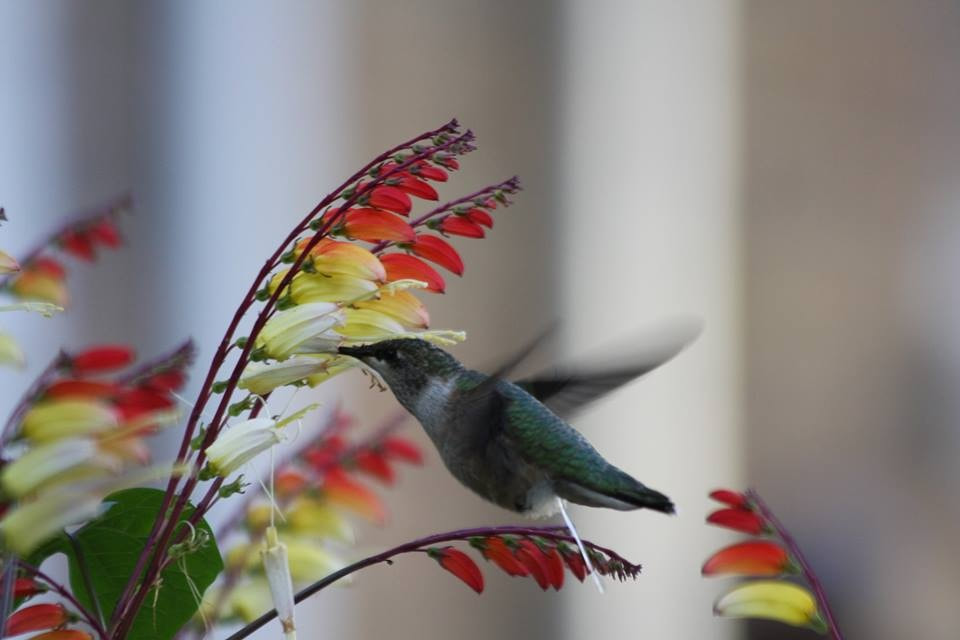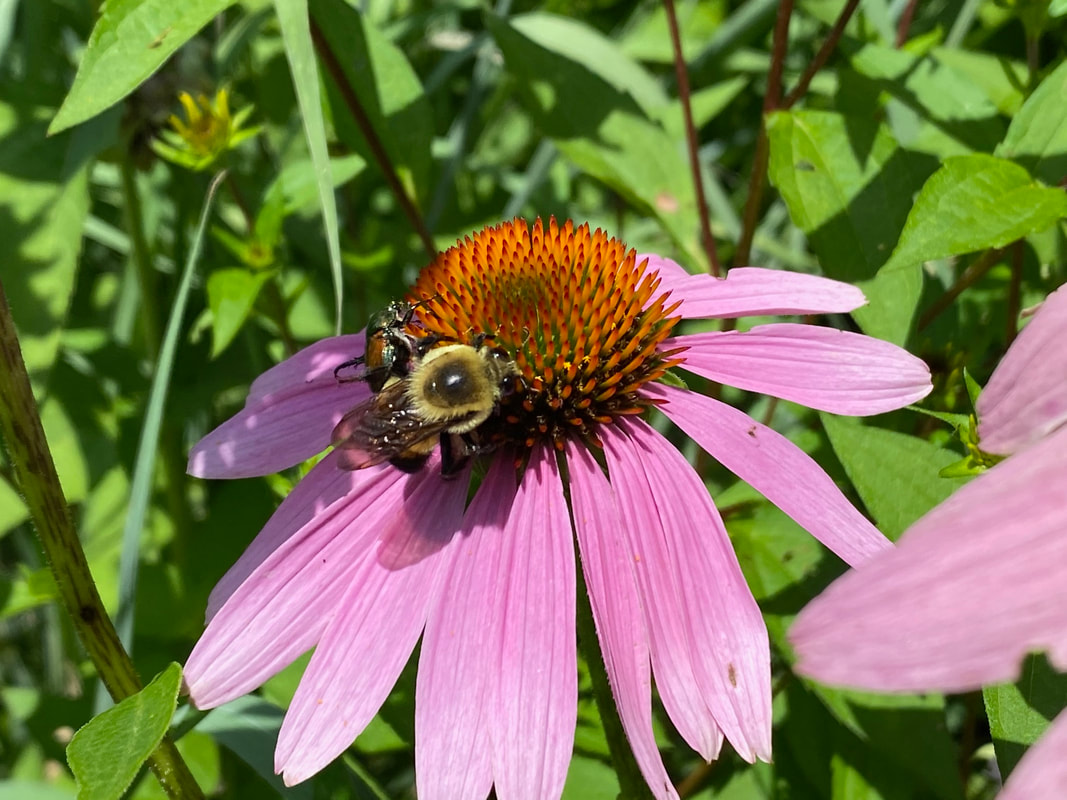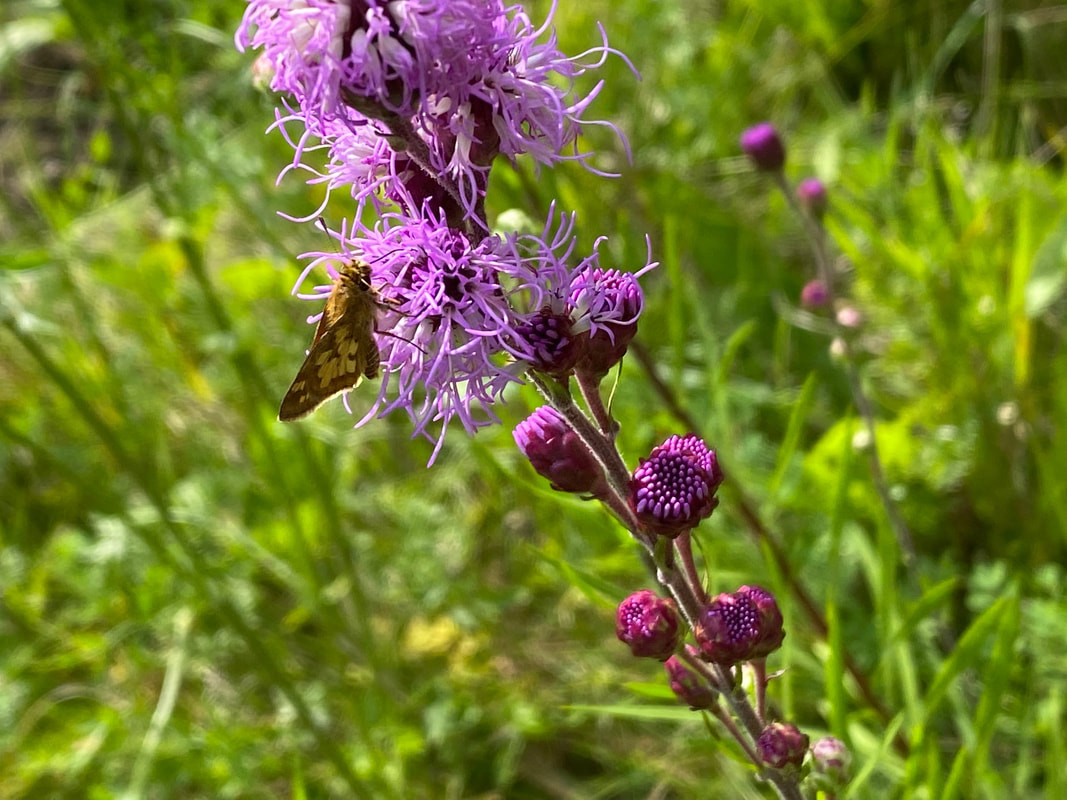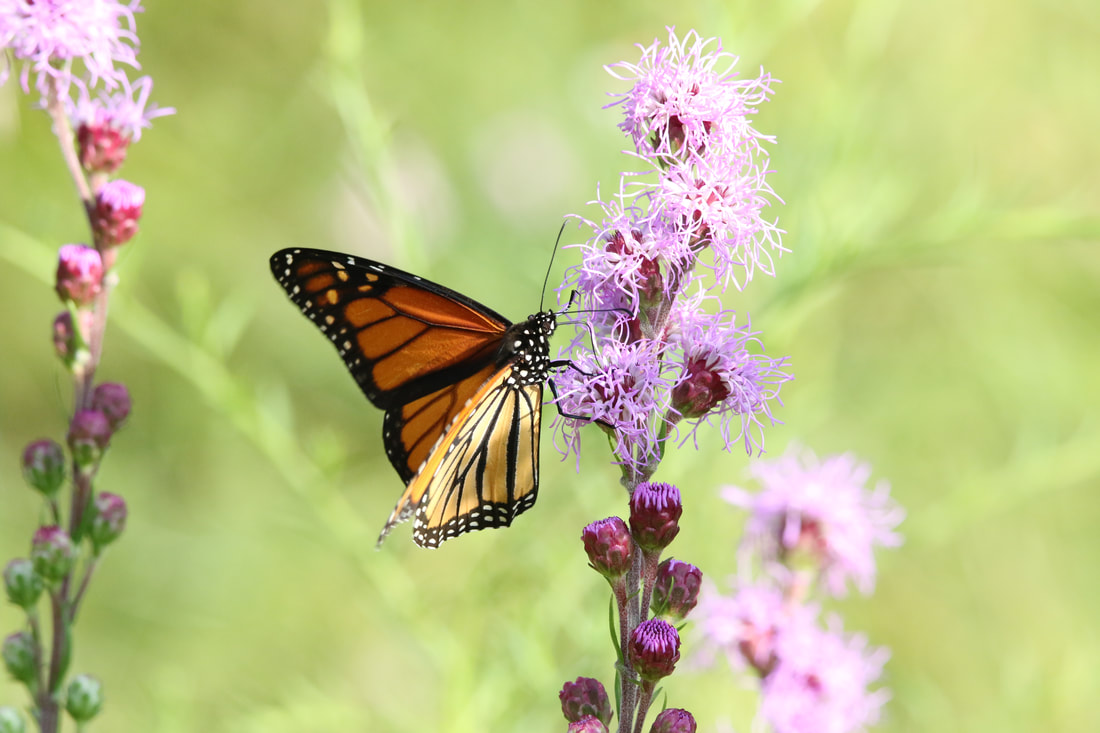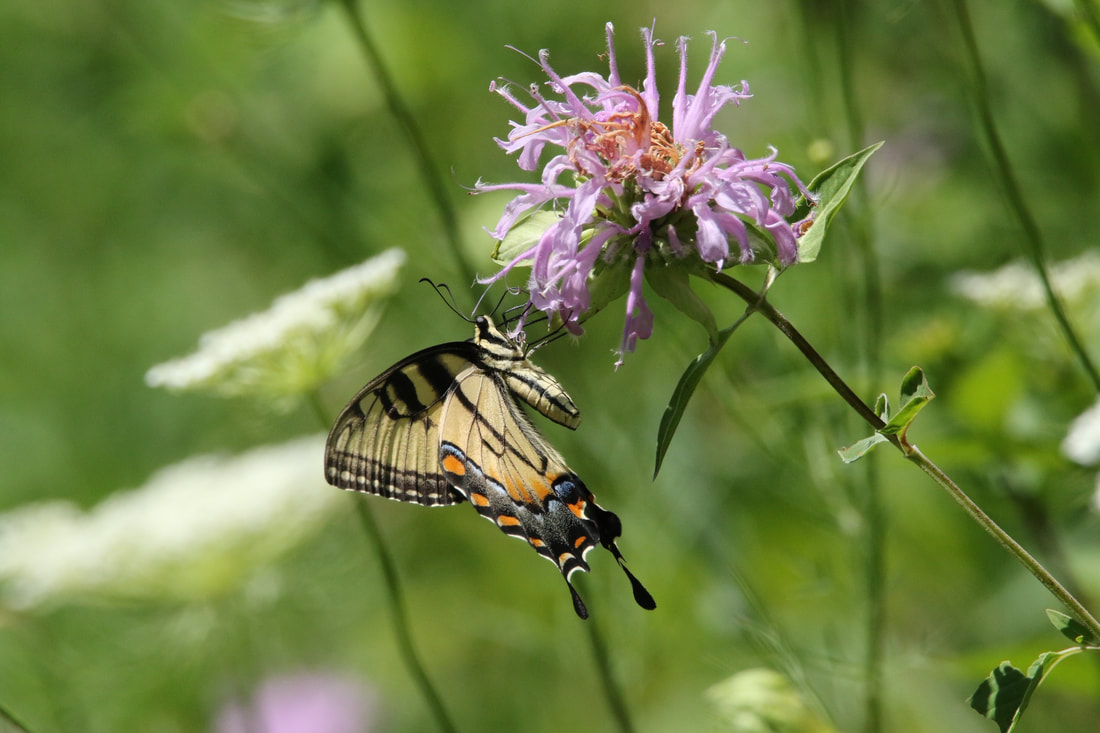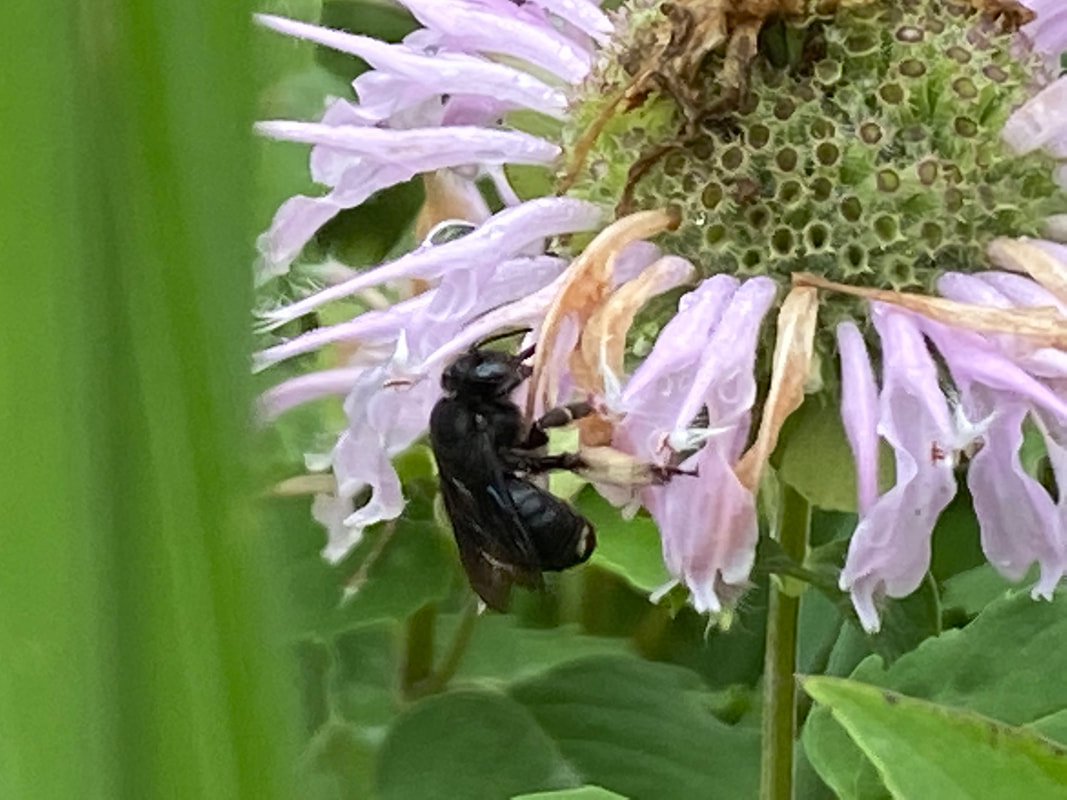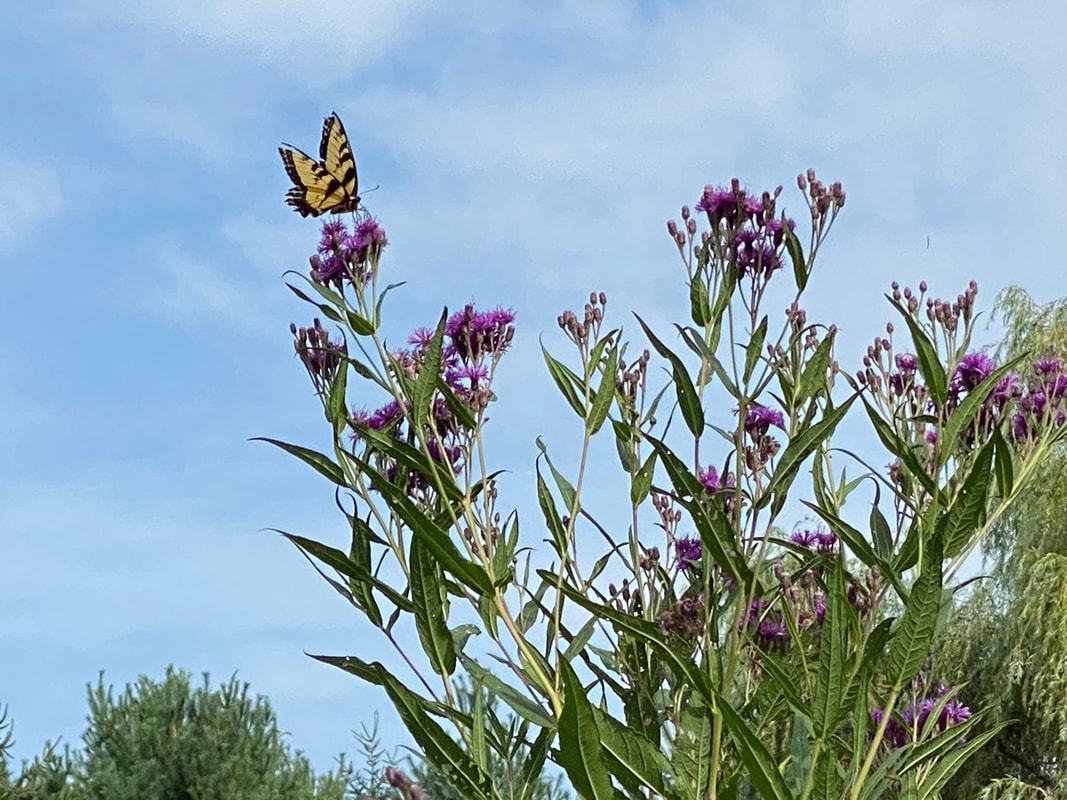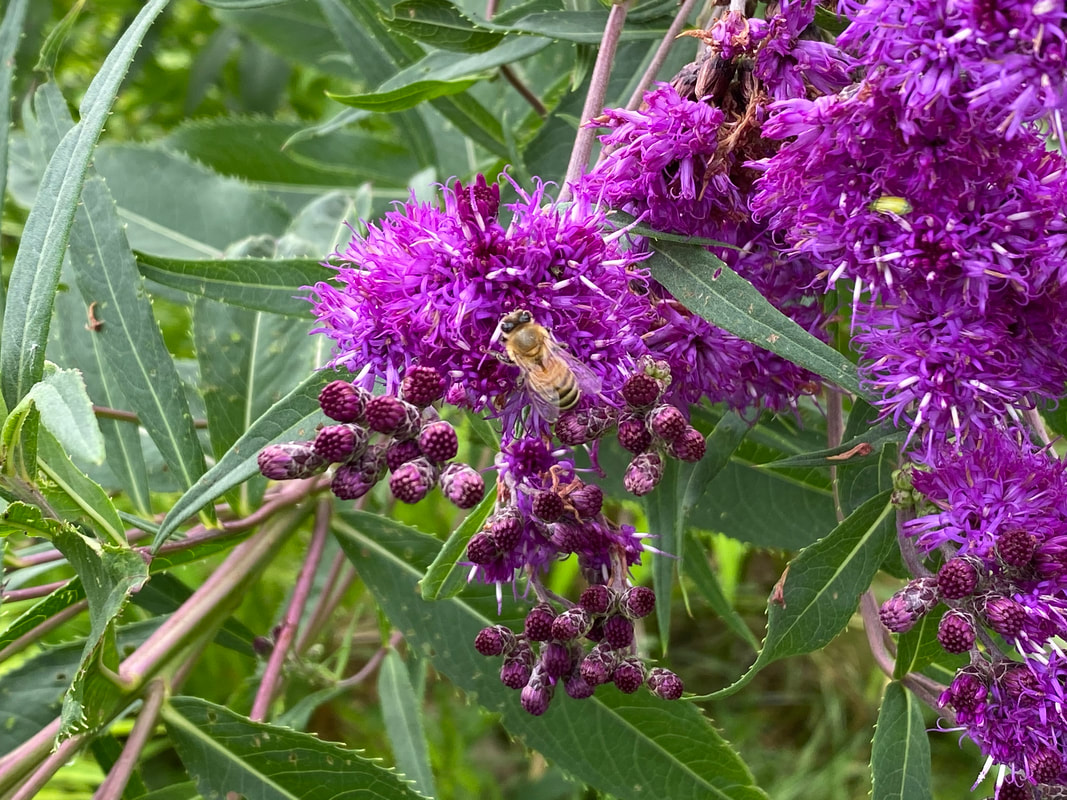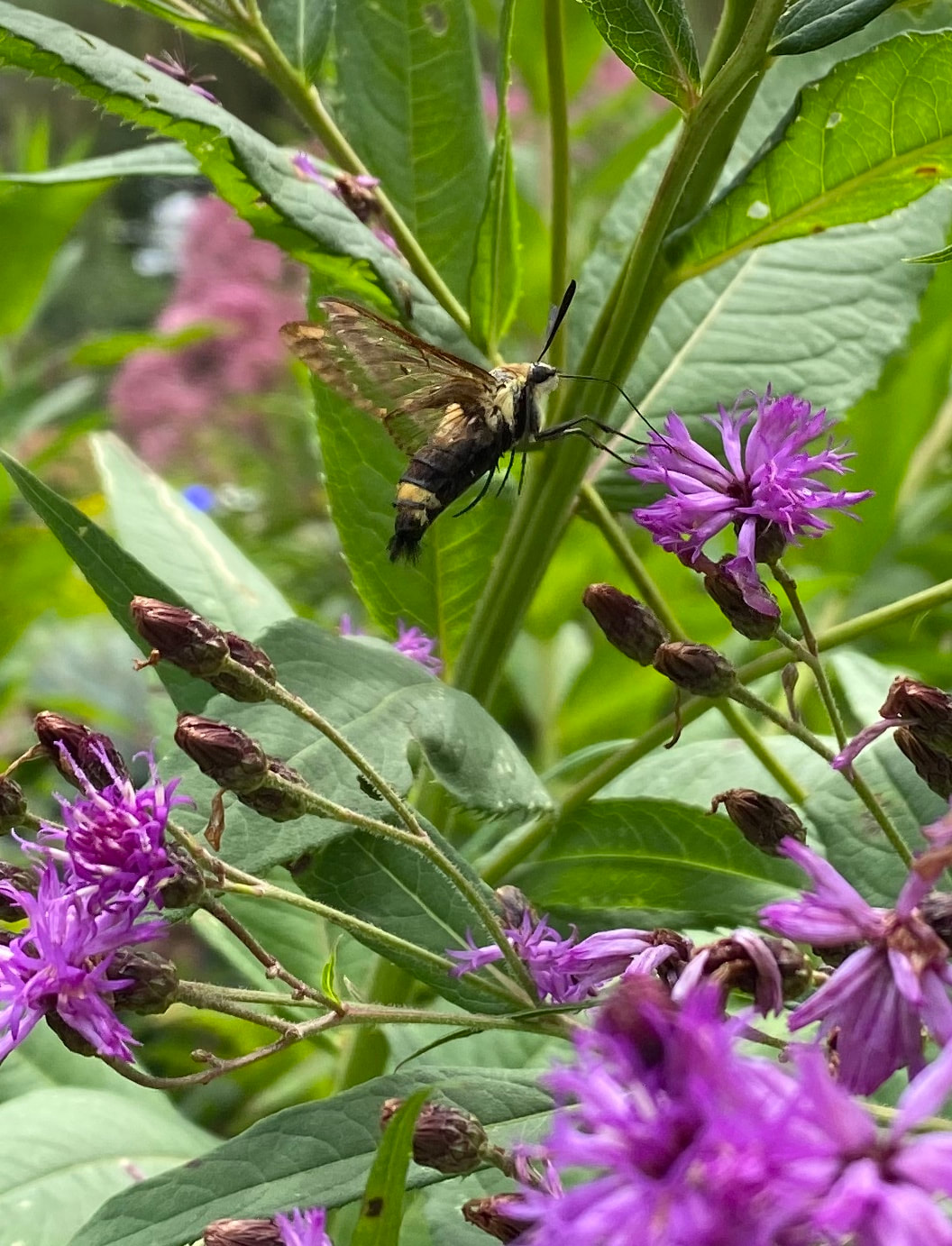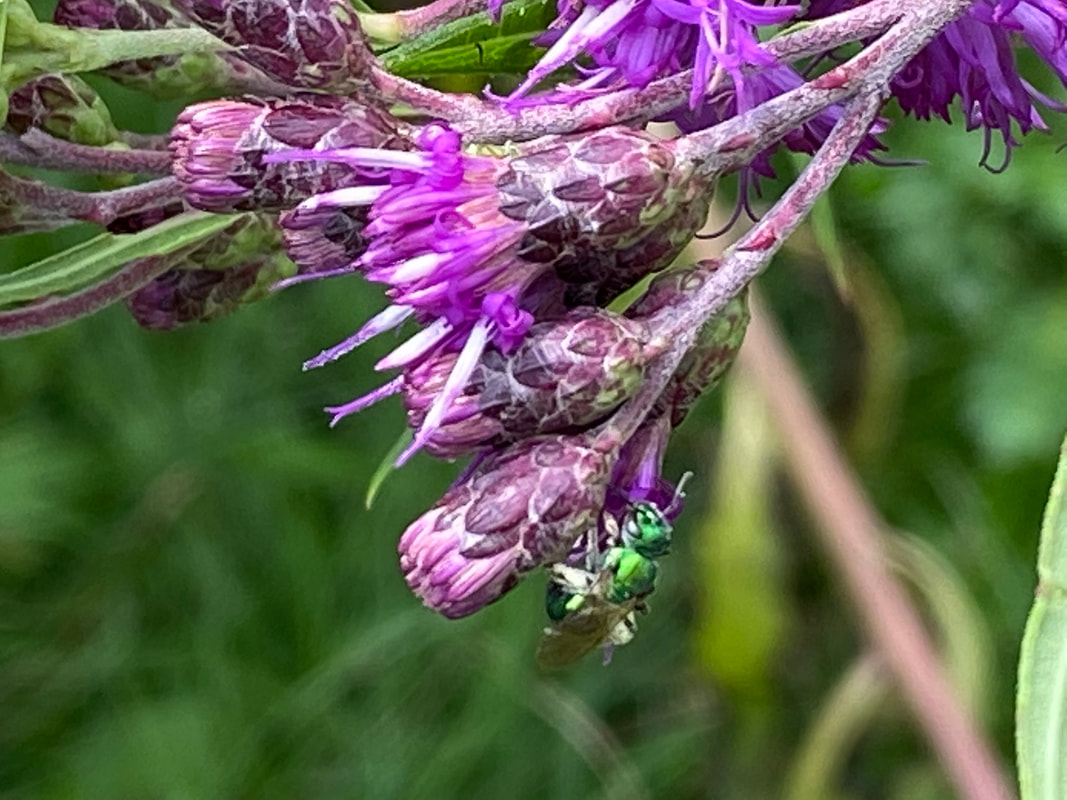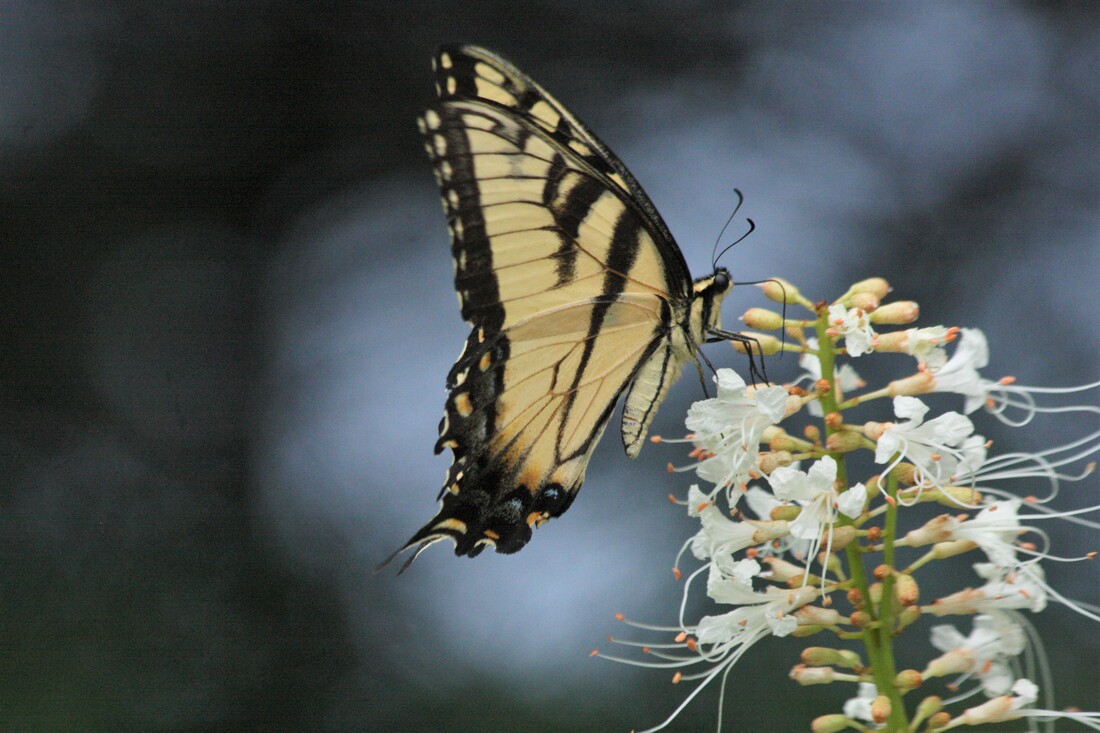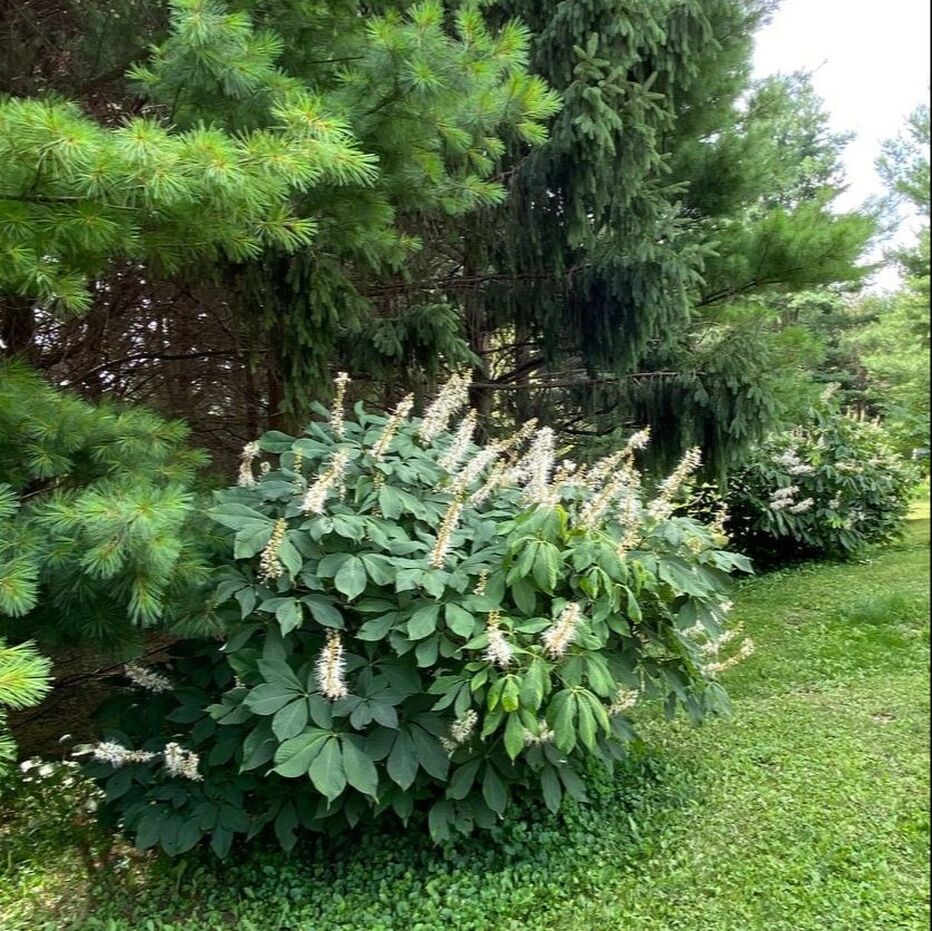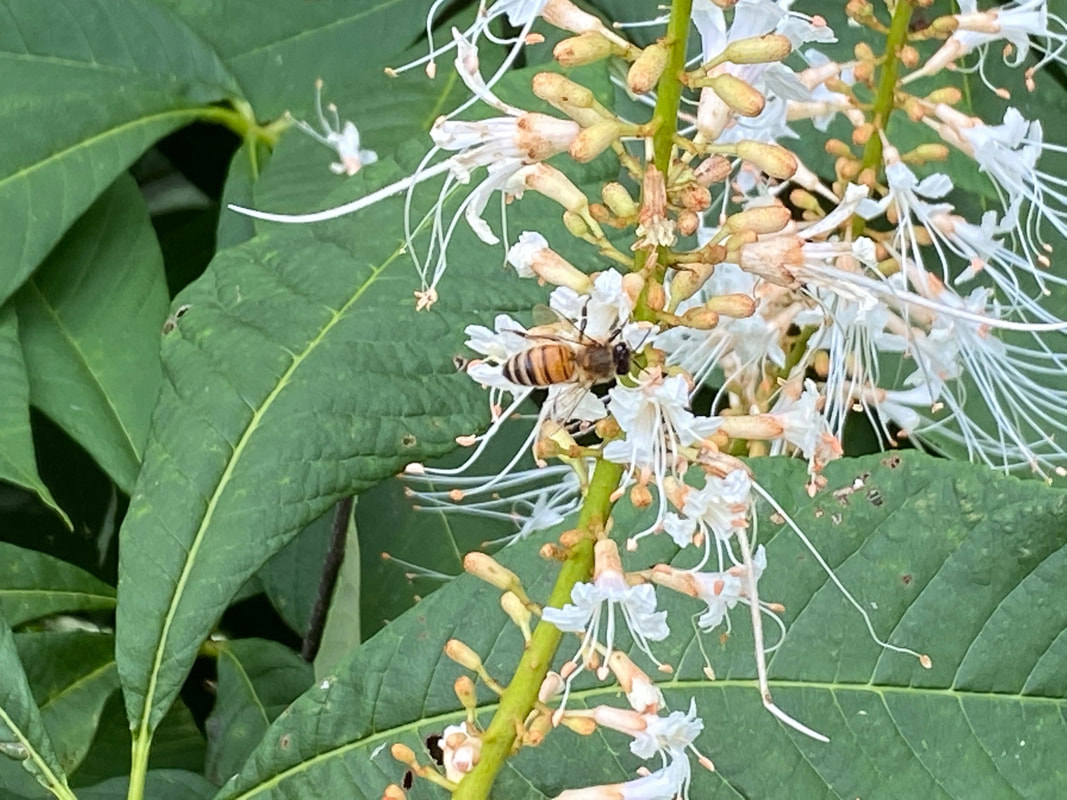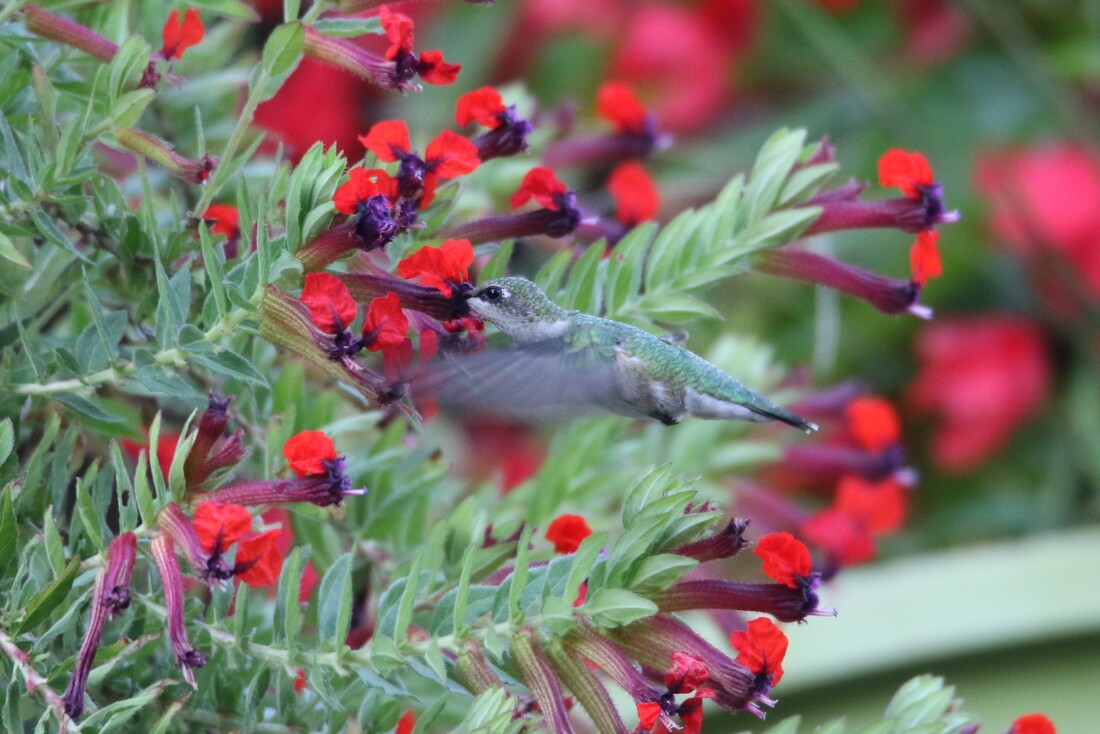|
This time of year is a little sad to me. The sun is setting significantly sooner, some trees and shrubs have long since stopped blooming and all the bird houses are empty as of today. The last tenants have evicted themselves. So I try to look on the bright side and now find myself a little giddy about all that is still going on. Tomatoes are roasting in the oven, garlic is cured and ready to use, red bell peppers, zucchini and all good things are overflowing. The other thing I look forward to is the blooming of the Seven Son tree or Heptacodium. It is a butterfly and bee magnet. My Seven Sons are ripe with full unopened blooms and now the wait is on for the first fragrant blossoms to open. I also enjoy the ninja hummingbird activity going on at the annuals on our deck and feeders. Hummers will chase anything! Another magnet that is starting to bloom is goldenrod. There are several versions of this and honestly I have no idea what variety I have. It showed up one day and has been a bit of a nuisance to manage, but I would not want to be without it. Again, bees all over it of all type and size. The other activity I enjoy at this time of year is seed saving. It typically starts with a tomato if I ate one I particularly love. I somehow feel a little wise that I have seeds on hand for next year. Out on the prairie, I really count on the wind and the goldfinches to disperse seed. Of prairie plants that I would like more of, I will collect the seeds to try to fill in barren spots. This could just mean cutting off a dried head of Echinacea (coneflower) and shaking it in a barren spot or gently rubbing two coneflower heads together to dislodge seeds. But if I want to be assured, I will pull a few weeds, come in contact with the soil and put a few of it’s seeds barely under the soil. Enough to hide it from hungry birds and to help propagation along. And myself of course, because it will grow where I want it. There are a few seeds that I must harvest to be sure I have the plant the following year. Some of these are annuals, like castor bean, Cleome and Tithonia. And the best of all is the perennial milkweed, any and all varieties. Let’s start first with a general idea of any seed saving. Whether it is from annual or perennial, you want the healthiest specimen. You do not want to take seeds from a plant that was barely producing, was weak stemmed, had washed out color or was not prolific. You want to take from the best of the best. Once you have the plant picked out, you have to wait until the plant has started to die back or a flower head that has died back. In the case of Echinacea (coneflower), even with bird activity, I can find a few that aren’t fully missing their seed. It is easy to look at the top of the plant to see if seeds remain or not. You can always place some lightweight gauze bag or something similar over the seed head so that birds do not get it before you do. Cleome is just kind of fun to take the seed from. As the flower grows taller, it leaves a pod behind. You do not want green pods but you may want to identify healthy green pods that you want to come back to later when they are ready to take. You want to take seeds from the brown ones that are just starting to split. I don’t even take the pod off, I just rake my finger over the pod and pop them into an envelope. If I know where I want some next year, I will scatter some in the area and then save the rest to scatter in the early spring. Cleome is an annual but if it drops it’s seeds, it can reseed itself with a reasonable winter. Tithonia can not survive a hard freeze, and I am not sure about it’s seeds other than they can not survive our winters. So I like to get outside while the weather is pleasant and start collecting some of the dead heads, in other words, not this 90 degree (!) week. I see plenty of hummers and insects coming to Tithonia for pollen and nectar, but not for seeds...that I can recall. So I will watch for it this year. Tithonia isn’t easy to extract the seed from. It is a bit prickly to touch.When the head is dried and usually crumpled over, I go by with scissors or pruner and snip the flower heads off into a paper bag. I don’t bother handling them. I leave them in a sunny dry space for a while and then move them inside for winter and keep them in a cool dry location like a basement. Every so often, I will go by and shake the bag. This separates the seed from the flower, and then I have easy-to-handle-seeds to plant after discarding the flower structure. This is a plant I always start inside and transplant to the outside when the ground is nice and warm. Because it is more of a late season plant, I try to give it a head start. You can always buy it already growing at BGC. There are times when I just can not coordinate myself to start seed and this COVID year was one of them. So luckily, I know I can get it at work and am sometimes the person that gets to water and tend to some of my favorites. Milkweed is a different story of sorts. It is trickier. You can treat it like Tithonia where you put the pod in a bag and shake it, but that is going to be a lot of shaking and a lot of fluff to float out at you once you do! I want a fluff-less home! I have set off the fluff in the house before and regretted it, so, I have a foolproof OCD-lovin’ way to separate seed from the fluff. First, you have to be sure you get the pod in the right state of readiness for picking, but not ready for free flying seed! You want to collect pods off plants when they have started turning brown and when they just start to open at their ‘seam’. To keep them in this state and not get fluffed, you can put a loose rubber band or tie a string around it. I do not bother doing either of those, but if you aren’t going to get to them for a few weeks, you will want to do so. I am so quick at separating the seed now, that it is a quick clean job when I bring a pod into the house. First, get paper bags and/or containers and label them with the seed type. I collect mostly Common, Swamp, Whorled and butterfly weed. I label paper bags to drop only those pods into each bag and bring them home. Be aware that Common milkweed pods look much larger than any of the other milkweed pods but the seeds themselves look about identical to the others. So bag and container labels are a must! Then I take old restaurant take-out delivery containers to prepare to put the seeds into. I collect a lot! Envelopes or paper bags work if you are doing just a few. All the milkweeds basically operate the same way:
If you have, don’t think something bad is happening. It is a good thing. Somewhere likely nearby, in a dead stem of a plant or dead section of a tree limb, a leafcutter bee has stored it’s eggs for next season's pollinators. These little circles of leaves is what separates one egg/larva chamber from the next. Like a little studio apartments for bees! Try to NOT be too tidy cleaning up your yard. Leave some dead items around because they likely harbor good things like bees for next year. And remember, if you are going to use any type of weed killer or insecticide, remember they kill good insects as well as pests, so use very sparingly. You will make these beekeepers very very happy. And if someone gives you a hard time about leaving dead stems or limbs around, tell them you are providing habitats for birds and insects and if they don’t like it to come see me!! If you have planted any of the items we have discussed over the last four blog postings, let us know about it. What did you plant and why did you choose that particular plant? I hope you had a great, err, reasonably good summer in this strangest of summers. Remember, contact with the earth always makes you feel more grounded, is good for you body and soul, and helps you to stay planted. Beth Martin is a BGC employee, Master Gardener, Master Composter, and Naturalist.
6 Comments
When talking about annuals, you are assured of one thing. They are not native! Annuals typically only survive in climates warmer than ours. Our winters are too harsh for them. Some of them might have seed that can survive, but the original plant will not. But before we talk annuals, back to shrubs one more time. The heavy rain of last week put an end to my bottlebrush buckeye blooms but now I see swallowtails and other butterflies and bees on my hydrangea paniculata ‘White Blush’ and Clethra Summersweet, Clethra alnifolia. Because Clethra is a late season bloomer, they have recently sprung alive with fragrant blooms that look like mini bottlebrush buckeye blooms. These are slow growers to me and this is the first year they have really bloomed. I am quite pleased with what I see and would plant a few more of these next season. I know where they will go too...they tolerate wet soil so they will go to a low lying area of the yard where they will do the most good and be happiest. But be aware that they are one of the last shrubs to show signs of life in spring. Patience is needed. Likewise, Deb from BGC has chimed in to say she sees many Swallowtails as well as small pastel butterflies and a wide variety of bees on her Hydrangea paniculata ‘pink diamond’ shrubs. I have a wide variety of hydrangeas on my property and it doesn’t seem that, when it comes to pollinators, all hydrangeas are equal. Some seem more popular with pollinators than others but that could be due to when they are at their peak pollination. So, if you have them, take a look and see who prefers your hydrangeas and what type they are. Let us know in the comments below if you see preferences like Deb and me. Now, onto our non-native pollinator enhancers! Why would annuals be so important? Shrubs and perennials have their moment in the sun and then their blooms fade away for the rest of the season. Annuals tend to bloom consistently all season as long as they are well watered and fertilized. So they can keep blooming well into fall as long as conditions are right. If pollinators can find them, they give them those all important last chances to help bulk up food stores for migration or hibernation. My absolute favorite is the first one on my list because it is important for Monarch migration. And I think we all know by now, Monarchs need our help.
Almost any annual will benefit our pollinators and there are more good annuals besides those suggested above. Maybe these will give you a few new ideas for plantings you would like to do for next year. Or if you are a fan of a particular pollinator, some of these specific suggestions may further help you attract them to your yard. The important thing to remember is:
What is the result of all of this hard work on your part? For me, I took about an acre of property and have struggled to turn it into a prairie. I fail, succeed, fail, succeed, etc. But overall, I am heading in the right direction. It helps to have a partner who helps you pull invasives and listens to you debate the merits of this plant or that plant. He nods his head, smiles, agrees and pulls another weed. But it gives me great joy to see him with his phone out trying to take a picture of a bee he has not seen before or of a bird that is in the prairie and does not visit the feeders. Every year our insect quota seems to be greater. And with that, you get some surprises. For the first time ever last week, we have seen mating monarchs. I wasn’t sure what I was seeing at first, but this morning, I saw another mating pair. The result of this pairing will be the monarchs that live 8-9 months that will make the difficult trek back to Mexico. There is a saying something to the effect, “it’s the little things in life that are important.” All the hard work seems worth it to know you have created a space with a goal in mind and have achieved it. Pollinator week is June 21-27 next year. Do yourself a favor. In these times of uncertainty, nothing keeps you more grounded then being in touch with nature, getting plenty of vitamin D from the sun and helping out nature. Buy a single plant of anything we have discussed in this series and plant it this week. You will be at the beginning of a wonderful path that gives you joy... along with an occasional back ache. If you get a chance, let us know what you plant in the comments below.
Next time, we can discuss a little seed saving. It makes my OCD happy. Beth Martin is a BGC employee, Master Gardener, Master Composter, and Naturalist. The 10 Best Perennials for Pollinators by Beth Martin As hard as it is to pull myself away from the bottlebrush buckeye, I am going to do so to talk about perennials. But before I do, I would like to say something else on behalf of the bottlebrush and the other shrubs. Choose a variety of shrubs that will offer flowers through the season: Early spring - red buckeye, autumn splendor buckeye, Fort McNair, serviceberry, chokeberry Late spring/early summer - St. John's Wort 'Ames', bottlebrush buckeye, Kodiak Red honeysuckle Late season - seven sons tree I discussed these in the last blog post. You can read it here. Bolded shrubs are still available at BGC. One thing consistently recommended for the benefit of bees, and honey bees in particular, is mass plantings so the bees do not need to figure out how to best collect pollen by going between different types of plants. In this way, shrubs are really superior in that they are already a mass planting. Bees and other pollinators can flit between buds without changing effective pollination tactics. So as we begin to discuss perennials, we want to keep in mind that planting them in numbered groupings will be most beneficial for your pollinators. A single plant is fine. But for the case of benefiting pollinators, more is better. Aesthetically, to our eye, it looks better also. So now let’s make sure we have hardy show-stopping perennials to add to those shrubs. What could be more obvious as a perennial pollinator than the beloved and reviled milkweed?! Loved for the fact that it is solely keeping the monarch butterfly population alive, but reviled because it sometimes does not know it’s place. I am one of those odd gardeners. Wherever it wants to pop up, it can pop up. I drop a bamboo stake in the ground where I see them crop up to mark the area. Hopefully I see it before I cut it down to size with my supersize mower. Surprised I have a supersized mower? Me too...but I am working to take away its domain. So, common milkweed (Aesclepias syriaca). Reliable? No. Not in the sense that it will come back up where you had planted it previously, but it likely will come up. Why is it important? Because it is the life source of monarchs. Will other milkweeds do? Certainly. But if you have ever raised monarchs, you know there is no other form of milkweed that has the large leaves of the common milkweed. And if you have hungry caterpillars at home, you want common milkweed. So let’s just agree to love it and bring about it’s best tendencies, okay?!? My favorite milkweed is Swamp milkweed (Aesclepias incarnata). I like it best because it generally comes back up right where it was the previous year. You want to be sure you keep weeds at bay, because it does become less reliable with thick grass or creeping charlie or another ground covering weed. Sometimes it’s hard to think of it as a milkweed because it is a classier looking plant than the common. The same is true for butterfly weed (Aesclepias tuberosa). That bright orange is such a showstopper for me. The color of the unopened buds is the color of a spectacular sunset in my eyes. So raise all 12 Wisconsin native milkweeds if you would like, but be sure to go heavy on Common, Swamp and Butterfly weed. To see all 12 types of Wisconsin milkweed, visit https://madisonaudubon.org/s/WisconsinsMilkweeds-printerfriendly.pdf Also, save the seeds if you want more of that particular plant. We can talk about seed saving at a later date. Those are the givens for the monarch population, egg laying through enclosing (emerging butterfly stage). Once a caterpillar has become a butterfly, their nectar needs change and there are several additional plants that are important for the monarch butterfly as well as other native pollinators. And of course, the best possible perennials are our native species which will attract the most pollinators. I tell customers at Burlington Garden Center all the time that I have my top 10 perennials or annuals and then stop myself to ask “Where is this plant on my list?” So here it is, based on my observations from my own garden. By the way, if you have the 2020 BGC t-shirt, you will find many of my favorites on it!
So I went a little beyond 10. I could keep going but these are the plants on which I have observed the most activity. But keep in mind, downy phlox, smooth phlox, stiff coreopsis, goldenrod, prairie dropseed, columbine are also plants that could slide into this list.
Once you have some good backbone trees and shrubs, you can work groupings of three of these into your garden to mesmerize you during the spring, summer and fall. We walk our gardens daily to note any changes we see and to try and notice not just the big spectacular pollinators, but also the tiniest and less appreciated. Do I have non-native perennials in our gardens? Yep, I sure do. I can not pass them up either, but I make sure I have natives throughout as well. Over time, I have found myself appreciating the native selections more and more. Natives are so important to our pollinators, but next time I will tell you about a few of my favorite annuals which are particularly important early and late season to help our insects bulk up for hibernation and migration. Beth Martin works at Burlington Garden Center and is a Master Gardener, Master Composter, and Naturalist. Who wouldn’t be excited to see multiple types of swallowtails and hummingbird moths, monarchs, butterflies and dozens of types of bees on a single shrub? Some plants tend to be specialists, but the bottlebrush buckeye, aesculus parviflora, is a real generalist showstopper, beginning in July. I am not aware of another plant that has such a wide variety of appeal to pollinators. We live on a property large enough to host several Bottlebrush Buckeye. They can get quite large, around 12’ x 12’ (but can be pruned), and are a native to the USA, particularly in the southeast. They are tolerant of different soil types and prefer to be watered in periods of drought. They can be planted in full sun or part shade. We have some planted in heavy shade and they perform just as well, however, they are not as large as those in the sun. We use them mostly as an understory shrub but they could easily be used as a specimen shrub because of the pollinators they attract. Right now, our bottlebrushes are roughly 6 feet wide, deep and tall. They are called bottlebrush buckeyes because the flowers resemble a very large brush, around 12 inches long, that would be used to clean out a wine bottle. Each bottlebrush has hundreds of small flowers on it to form a single bottlebrush. So there are plenty of flower heads to go around for all the various feeders…even hummingbirds. The tiny green metallic bees may be one of my favorites to come to this shrub to feed. They are very small, about a third of an M and M (Covid snack food in this household!) with an entirely shiny head, thorax and abdomen. When not flying, their wings cover much of their metallic green bodies. These small bees are huge compared to some of the other even smaller varieties of bees that also pollinate this shrub. Remember, Wisconsin has over 400 different bee species. Having a shrub that attracts so many different pollinators is a great addition to any yard. As beekeepers, we are thrilled to see our honeybees throughout all our bottlebrush buckeye. Knowing what makes the honeybees happy helps us to be more successful with honey harvesting. But seeing the wide range of insects is even more thrilling. We have seen hummingbirds in the shrubs, two variety of the clearwing sphinx moth or hummingbird moth, 6 different swallowtails, monarchs, silver spotted skippers, a variety of large bumblebees, honeybees, green metallic bees, black bees and bees I could not begin to name. We have an area where we have three of these shrubs in a row. We are out investigating them at different times of the day just to see if the variety changes. So far we are thrilled with what this shrub adds to our overall garden. With bottlebrushes still forming, we have a long time to enjoy them. I cannot imagine not having this prize in our yard. If you plant one, I’m sure you will be impressed and thrilled with it as well. Be prepared to pull up a lawn chair to watch the non-social distancing pollinators! To keep pollinators happy, consider planting shrubs and small trees that flower at different times so pollinators are kept busy on your property. It can only help your crops if you are also growing food. For early spring, some of my favorites are red buckeye, autumn splendor buckeye (both of these beloved by hummingbirds!), serviceberry (which also has tasty small fruit) and chokeberry (which has small fruit to feed the birds). Late spring and early summer, I am a big fan of St. John's Wort 'Ames', a reliable well performing shrub that blooms July and August about the same time as the bottlebrush buckeye. I love it too for its small flowers that resemble buttercups. Kodiak Red honeysuckle (non invasive) is also a beloved pollinator shrub at this time of year. Yet to bloom would be another favorite of mine and the pollinators, the seven sons tree. I can not say enough wonderful things about this shrub. It is just as popular as the bottlebrush buckeye but is at that all important time of the year when the days are getting shorter and pollen is in shorter supply. It is fragrant and such a joy to watch as all types of butterflies, bees and hummingbirds migrate to it in numbers.
The shrubs listed above in bold are still available at BGC at this writing. Also, we have all of these except the autumn splendor buckeye (but we have the similar Fort McNair) planted on our property and have been observing them for several years now. There are other shrubs that could be placed into this article but I am only writing about what I observe on my own property. Shrubs I know can take some abuse and still bloom prolifically! One last clarification. On multiple occasions this spring, people asked me why something is called a tree yet it is multi stem, like the crabapple and seven sons tree by the pond at BGC. Many trees like crabapple and magnolias can be pruned to be trees but their natural habit is to be multi stem. Growers keep them single stem so they take up less room in the greenhouses. Makes sense. So if you do not want it to become more shrub in habit, you need to prune suckers. As for what makes something a tree vs a shrub in technical terms, a tree is over 20 feet and a shrub is under. But a tree can look like a shrub! There you have it. Coming up in the next addition, perennials and annuals to support your pollinators. Beth Martin is a BGC employee, Master Gardener, Master Composter, and Naturalist. All photos are taken by her. |
|
|
STORE INFO
5205 Mormon Road Burlington, WI 53105 262.763.2153 |

